SPECIAL TOPIC—Nonlinear physics
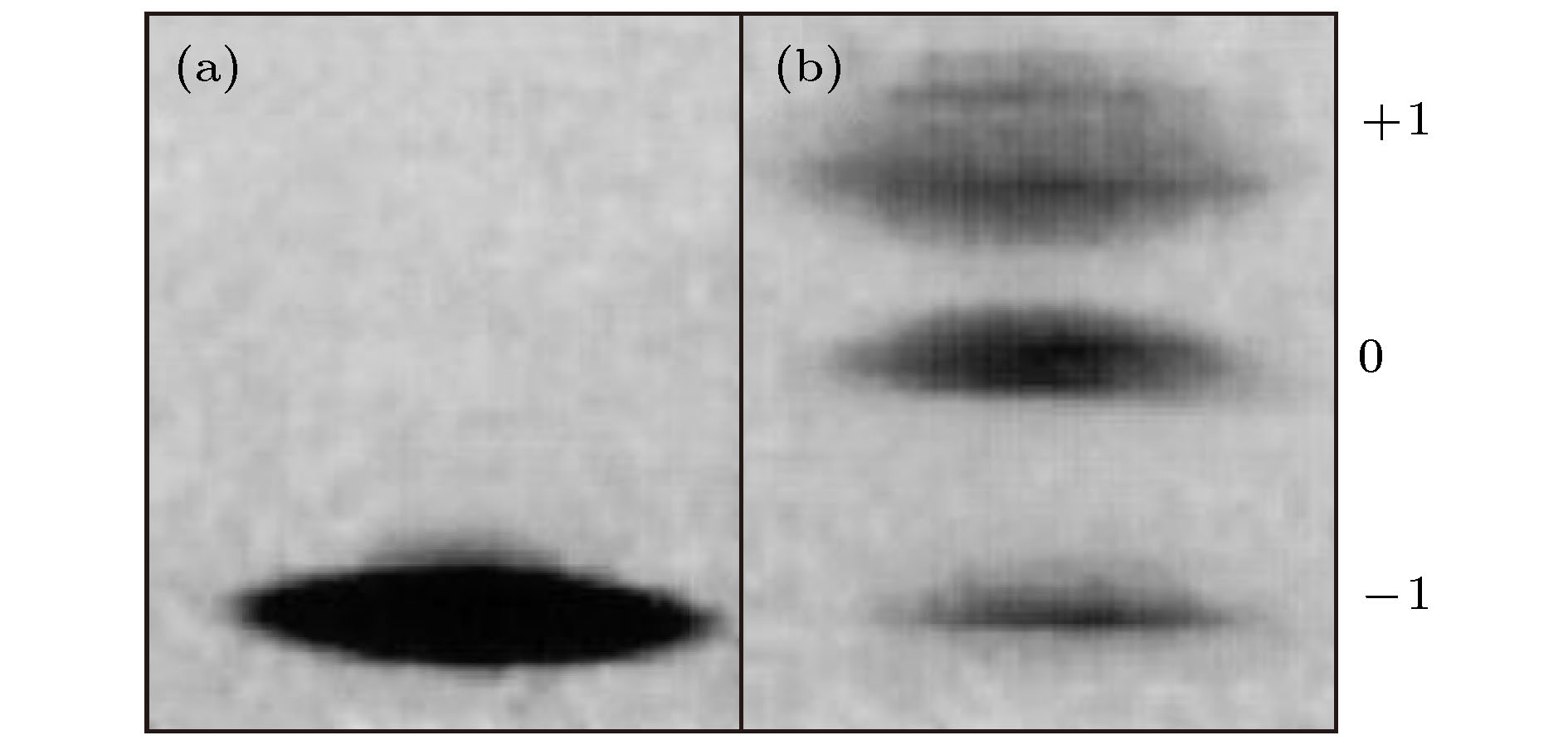
2020, 69 (1): 010303.
doi:10.7498/aps.69.20191648
Abstract +
Most of the atoms that realize Bose-Einstein condensation have internal spin degree of freedom. In the optical potential trap, the internal spin of the atom is thawed, and the atom can be condensed into each hyperfine quantum state to form the spinor Bose-Einstein condensate. Flexible spin degrees of freedom become dynamic variables related to the system, which can make the system appear novel topological quantum states, such as spin domain wall, vortex, magnetic monopole, skymion, and so on. In this paper, the experimental and theoretical study of spinor Bose-Einstein condensation, the types of topological defects in spinor Bose-Einstein condensate, and the research progress of topological defects in spinor two-component and three-component Bose-Einstein condensate are reviewed.

2020, 69 (1): 010202.
doi:10.7498/aps.69.20191647
Abstract +
In contrast to the well-established theory of differential equations, the theory of difference equations has not quite developed so far. The most recent advances in the theory of discrete integrable systems have brought a true revolution to the study of difference equations. Multidimensional consistency is a new concept appearing in the research of discrete integrable systems. This property, as an explanation to a type of discrete integrability, plays an important role in constructing the Bäcklund transformations, Lax pairs and exact solutions for discrete integrable system. In the present paper, the multidimensional consistency and its applications in the research of discrete integrable systems are reviewed.
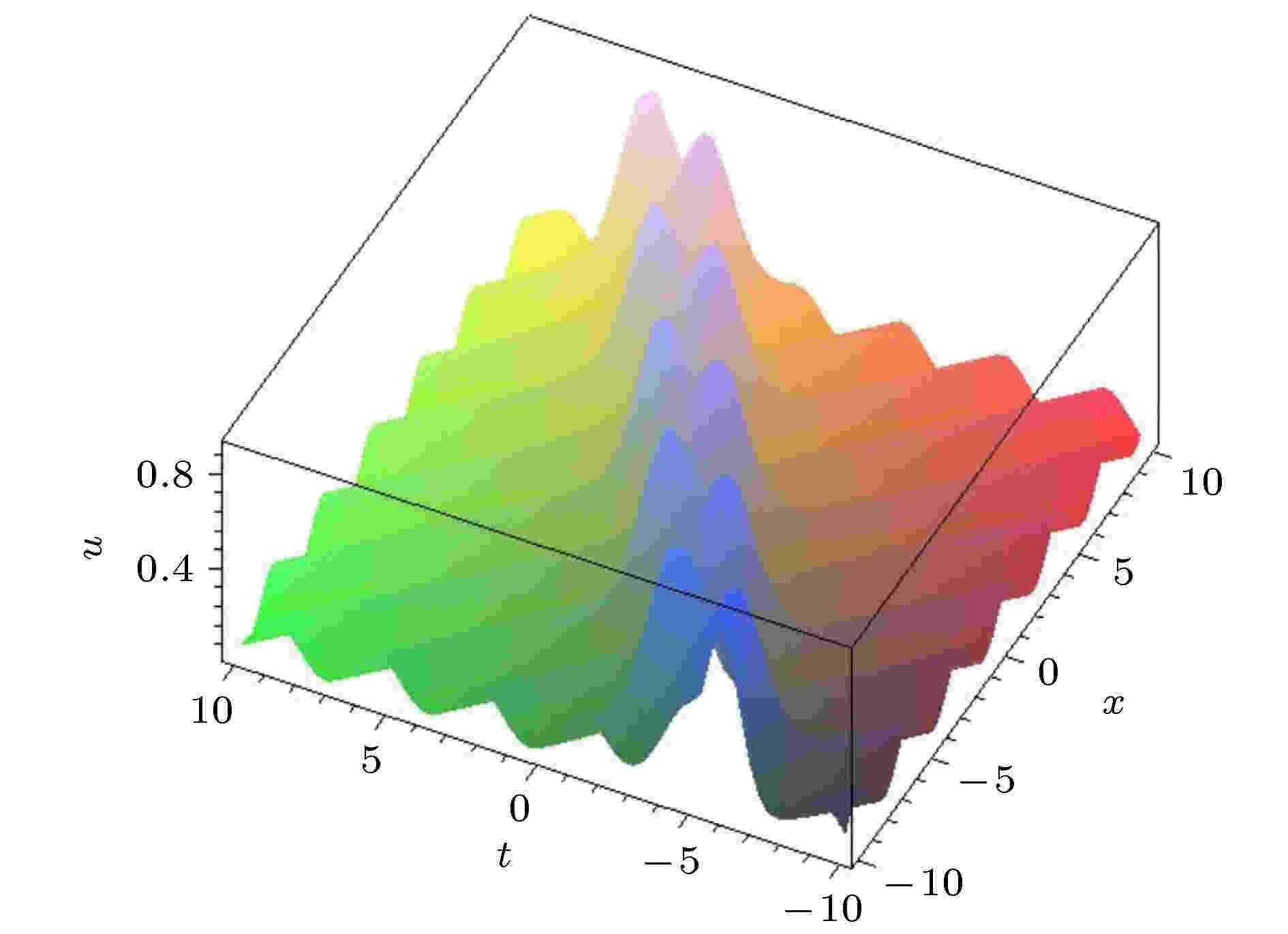
2020, 69 (1): 010203.
doi:10.7498/aps.69.20191316
Abstract +
The Boussinesq equation is a very important equation in fluid mechanics and some other disciplines. A Lax pair of the Boussinesq equation is proposed. With the help of the truncated Painlevé expansion, auto-Bäcklund transformation of the Boussinesq equation and Bäcklund transformation between the Boussinesq equation and the Schwarzian Boussinesq equation are demonstrated. Nonlocal symmetries of the Boussinesq equation are discussed. One-parameter subgroup invariant solutions and one-parameter group transformations are obtained. The consistent Riccati expansion solvability of the Boussinesq equation is proved and some interaction structures between soliton-cnoidal waves are obtained by consistent Riccati expansion.
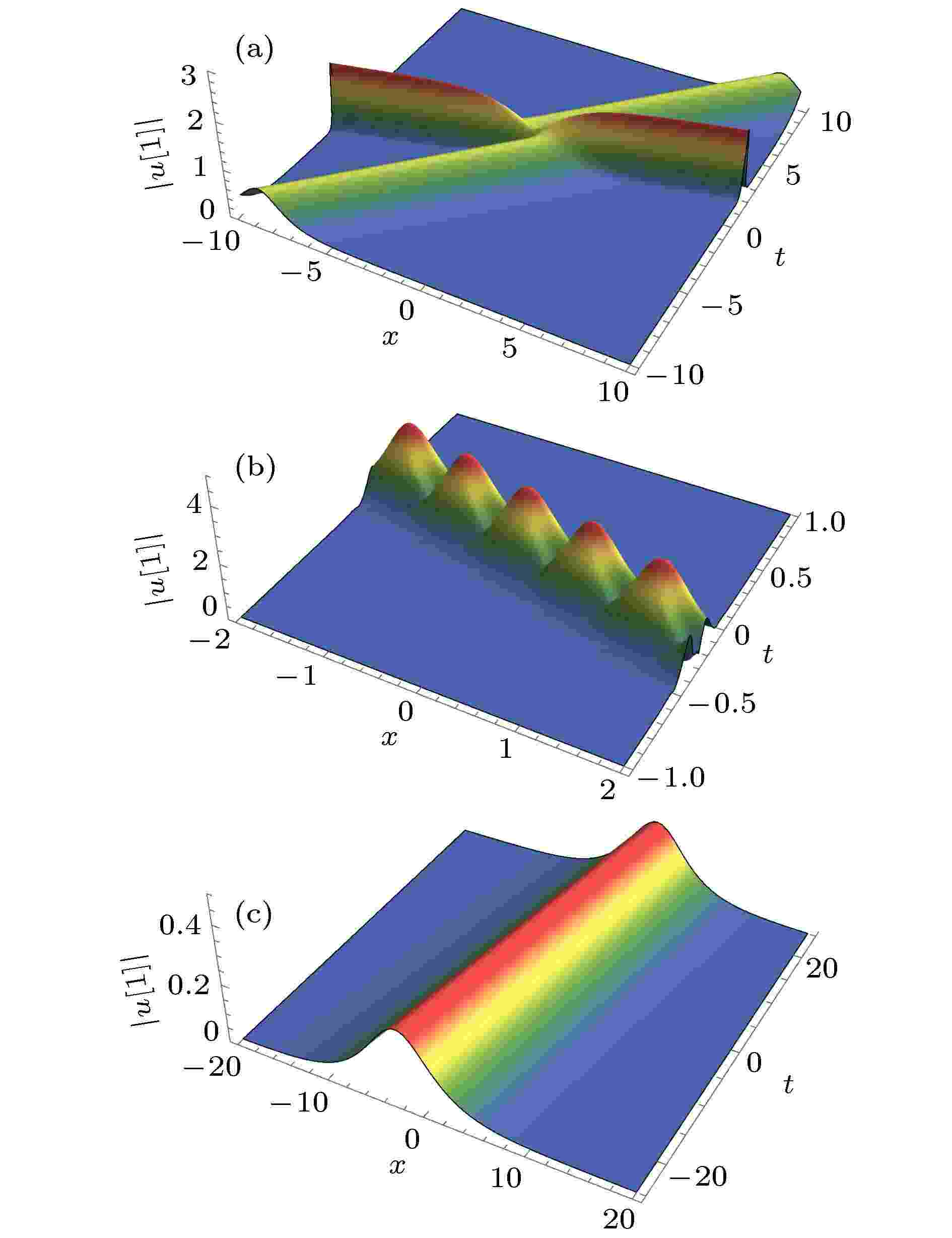
2020, 69 (1): 010204.
doi:10.7498/aps.69.20191887
Abstract +
In this paper, we introduce an integrable reverse space-time nonlocal Sasa-Satsuma equation. The Darboux transformation and soliton solutions for this nonlocal integrable equation are constructed.
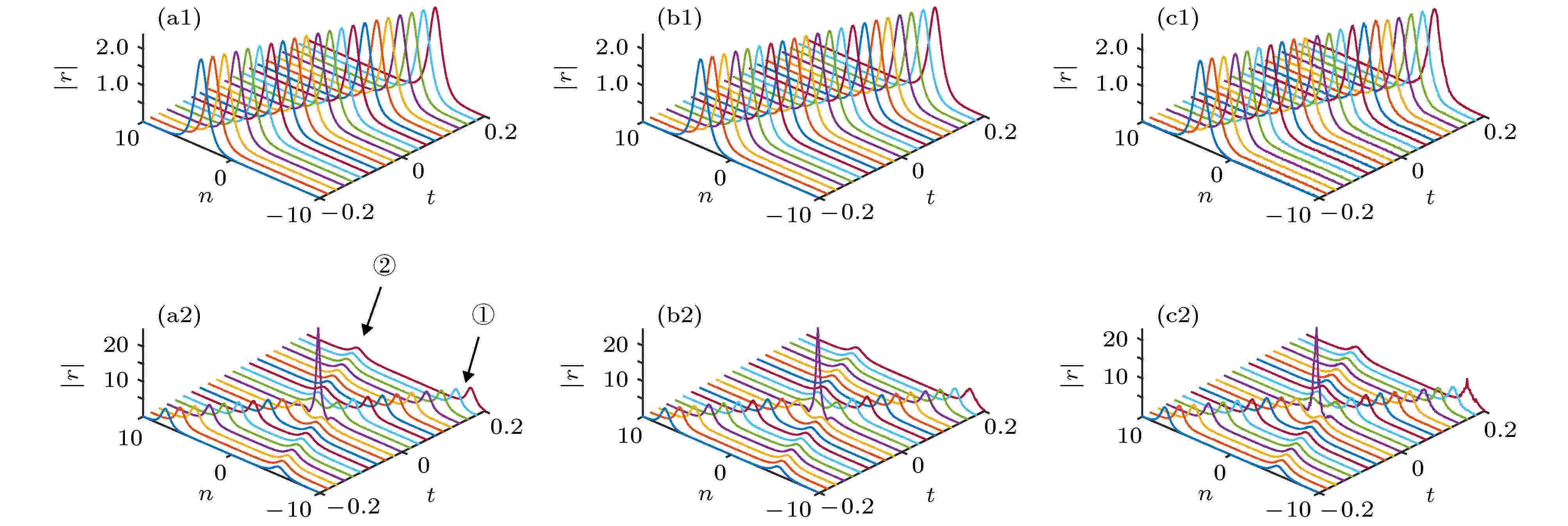
2020, 69 (1): 010205.
doi:10.7498/aps.69.20191235
Abstract +
It is an important research topic to study diverse local wave interaction phenomena in nonlinear evolution equations, especially for the semi-discrete nonlinear lattice equations, there is little work on their diverse local wave interaction solutions due to the complexity and difficulty of research. In this paper, a semi-discrete higher-order Ablowitz-Ladik equation is investigated via the generalized
$(M, N-M)$
-fold Darboux transformation. With the aid of symbolic computation, diverse types of localized wave solutions are obtained starting from constant and plane wave seed background. Particularly, for the case
$M=N$
, the generalized
$(M, N-M)$
-fold Darboux transformation may reduce to theN-fold Darboux transformation which can be used to derive multi-soliton solutions from constant seed background and breather solutions from plane wave seed background, respectively. For the case
$M=1$
, the generalized
$(M, N-M)$
-fold Darboux transformation reduce to the generalized
$(1, N-1)$
-fold one which can be used to obtain rogue wave solutions from plane wave seed background. For the case
$M=2$
, the generalized
$(M, N-M)$
-fold Darboux transformation reduce to the generalized
$(2, N-2)$
-fold one which can be used to give mixed interaction solutions of one-breather and first-order rogue wave from plane wave seed background. To study the propagation characteristics of such localized waves, the numerical simulations are used to explore the dynamical stability of such obtained solutions. Results obtained in the present work may be used to explain related physical phenomena in nonlinear optics and relevant fields.
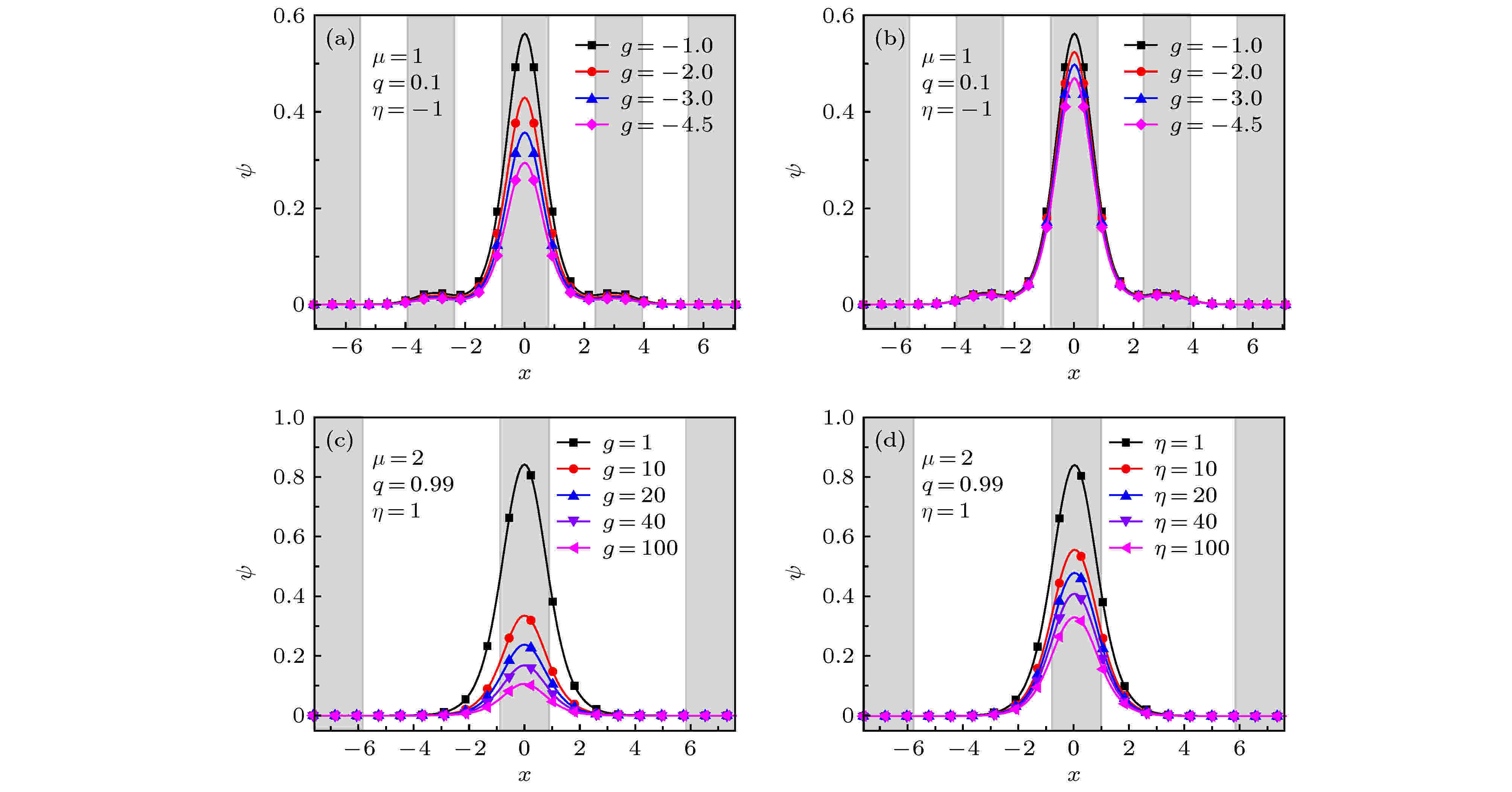
2020, 69 (1): 010301.
doi:10.7498/aps.69.20191278
Abstract +
We study the gap solitons and their stability properties in a Bose-Einstein condensation (BEC) under three-body interaction loaded in a Jacobian elliptic sine potential, which can be described by a cubic-quintic Gross-Pitaevskii equation (GPE) in the mean-field approximation. Firstly, the GPE is transformed into a stationary cubic-quintic nonlinear Schrödinger equation (NLSE) by the multi-scale method. A class of analytical solution of the NLSE is presented to describe the gap solitons. It is shown analytically that the amplitude of the gap soliton decreases as the two-body or three-body interaction strength increases. Secondly, many kinds of gap solitons, including the fundamental soliton and the sub-fundamental soliton, are obtained numerically by the Newton-Conjugate-Gradient (NCG) method. There are two families of fundamental solitons: one is the on-site soliton and the other is the off-site soliton. All of them are bifurcated from the Bloch band. Both in-phase and out-phase dipole solitons for off-site solitons do exist in such a nonlinear system. The numerical results also indicate that the amplitude of the gap soliton decreases as the nonlinear interaction strength increases, which accords well with the analytical prediction. Finally, long-time dynamical evolution for the GPE is performed by the time-splitting Fourier spectrum method to investigate the dynamical stability of gap solitons. It is shown that the on-site solitons are always dynamically stable, while the off-site solitons are always unstable. However, both stable and unstable in-phase or out-phase dipole solitons, which are not bifurcated from the Bloch band, indeed exist. For a type of out-phase soliton, there is a critical value
$ q_c$
when the chemical potentialμis fixed. The solitons are linearly stable as
$ q>q_c$
, while they are linearly unstable for
$ q
. Therefore, the modulusqplays an important role in the stability of gap solitons. One can change the dynamical behavior of gap solitons by adjusting the modulus of external potential in experiment. We also find that there exists a kind of gap soliton, in which the soliton is dynamically unstable if only the two-body interaction is considered, but it becomes stable when the three-body interaction is taken into account. This indicates that the three-body interaction has influence on the stability of gap solitons.
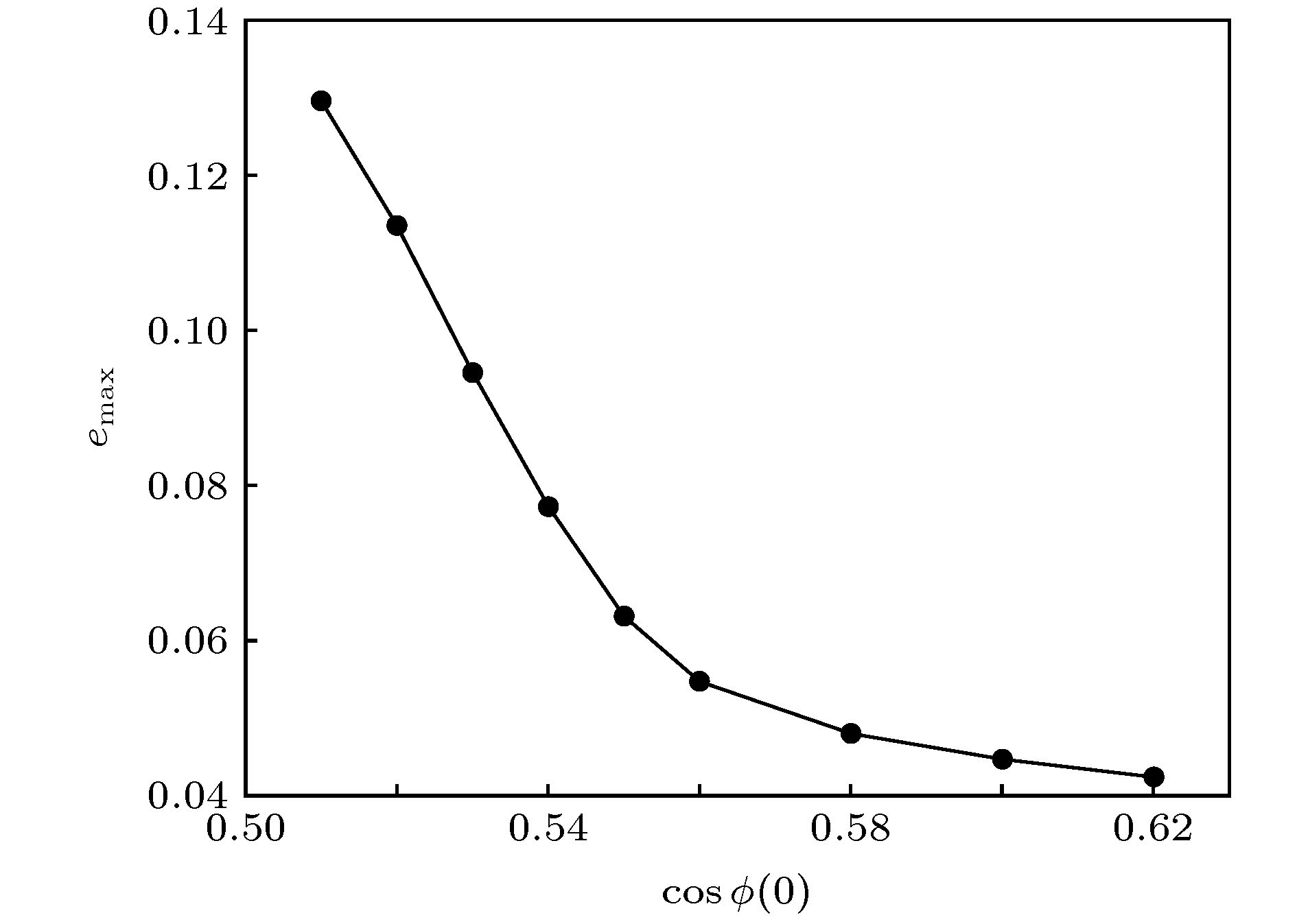
2020, 69 (1): 010302.
doi:10.7498/aps.69.20191424
Abstract +
Soliton is an exotic topological excitation, and it widely exists in various nonlinear systems, such as nonlinear optics, Bose-Einstein condensates, classical and quantum fluids, plasma, magnetic materials, etc. A stable soliton can propagate with constant amplitude and velocity, and maintain its shape. Two-dimensional and three-dimensional solitons are usually hard to stabilize, and how to realize stable two-dimensional or three-dimensional solitons has aroused the great interest of the researchers. Ring dark soliton is a kind of two-dimensional soliton, which was first theoretically predicted and experimentally realized in nonlinear optical systems. Compared with the usual two-dimensional solitons, ring dark solitons have good stability and rich dynamical behaviors. Owing to their highly controllable capability, Bose-Einstein condensates provide a new platform for studying the ring dark solitons. Based on the recent progress in Bose-Einstein condensates and solitons, this paper reviews the research on the analytic solutions, stability, as well as the decay dynamics of ring dark solitons in Bose-Einstein condensates. A transform method is introduced, which generalizes the analytic solutions of ring dark solitons from a homogeneous system with time-independent nonlinearity to a harmonically trapped inhomogeneous system with time-dependent nonlinearity. The stability phase diagram of the ring dark soliton under deformation perturbations is discussed by numerically solving the Gross-Pitaevskii equations in the mean-field theory. A method of enhancing the stability of ring dark solitons by periodically modulating the nonlinear coefficients is introduced. It is also shown that the periodically modulated nonlinear coefficient can be experimentally realized by the Feshbach resonance technology. In addition, we discuss the dynamics of the decay of ring dark solitons. It is found that the ring dark soliton can decay into various vortex clusters composed of vortices and antivortices. This opens a new avenue to the investigation of vortex dynamics and quantum turbulence. It is also found that the ring dark solitons combined with periodic modulated nonlinearity can give rise to the pattern formation, which is an interesting nonlinear phenomenon widely explored in all the fields of nature. Finally, some possible research subjects about ring dark solitons in future research are also discussed.
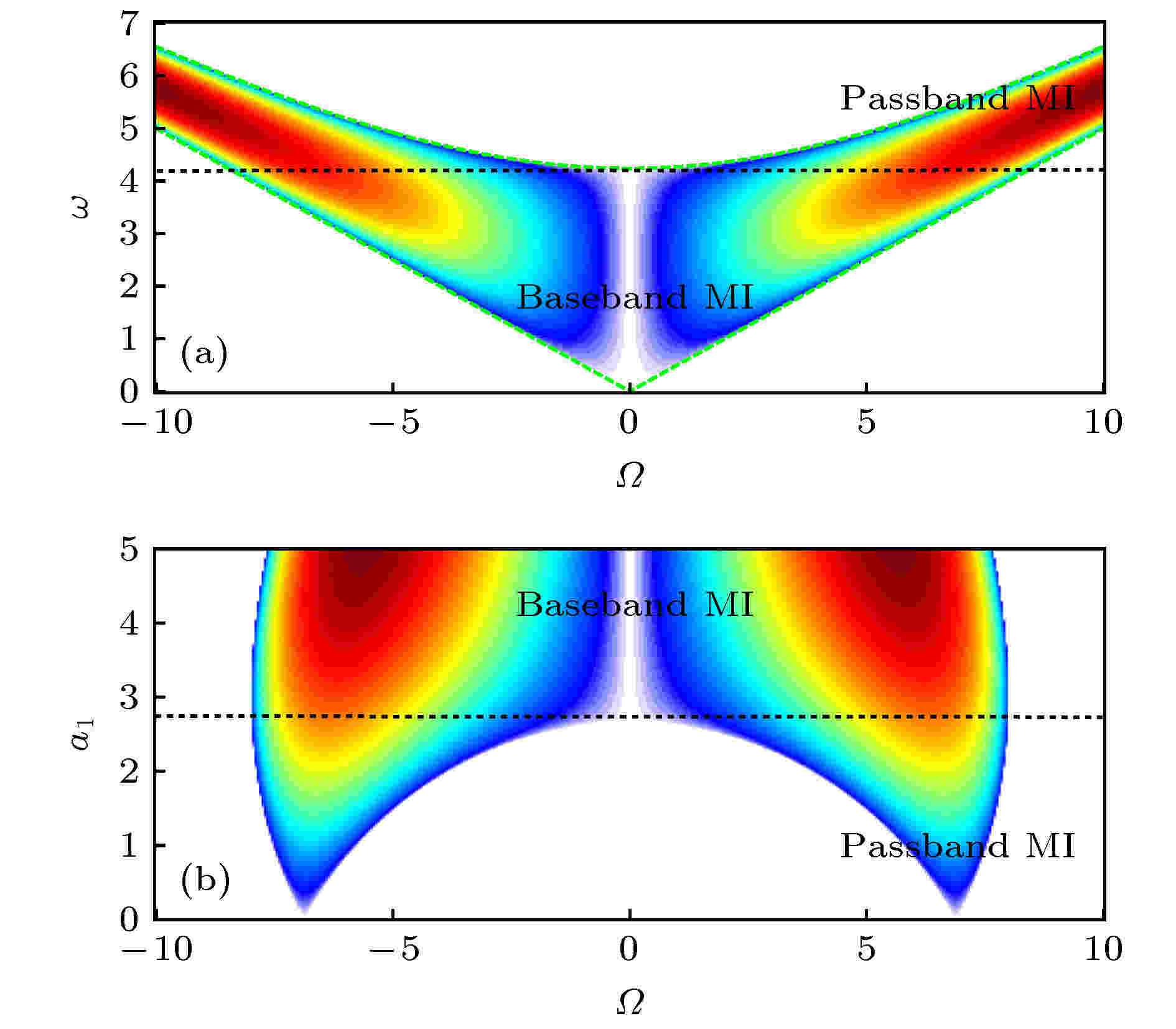
2020, 69 (1): 010501.
doi:10.7498/aps.69.20191385
Abstract +
Nonlinear waves are ubiquitous in various physical systems, and they have become one of the research hotspots in nonlinear physics. For the experimental realization, observation and application of nonlinear waves, it is very important to understand the generation mechanism, and determine the essential excitation conditions of various nonlinear waves. In this paper, we first briefly review the experimental and theoretical research progress of nonlinear waves in recent years. Based on the exact nonlinear wave solutions and linear stability analysis results, we systemically discuss how to establish the quantitative relations between fundamental nonlinear waves and modulation instability. These relations would deepen our understanding on the mechanism of nonlinear waves. To solve the excitation conditions degenerations problem for some nonlinear waves, we further introduce the perturbation energy and relative phase to determine the excitation conditions of nonlinear waves. Finally, we present a set of complete parameters that can determine the excitation conditions of nonlinear waves, and give the excitation conditions and phase diagrams of the fundamental nonlinear waves. These results can be used to realize controllable excitation of nonlinear waves, and could be extended to many other nonlinear systems.
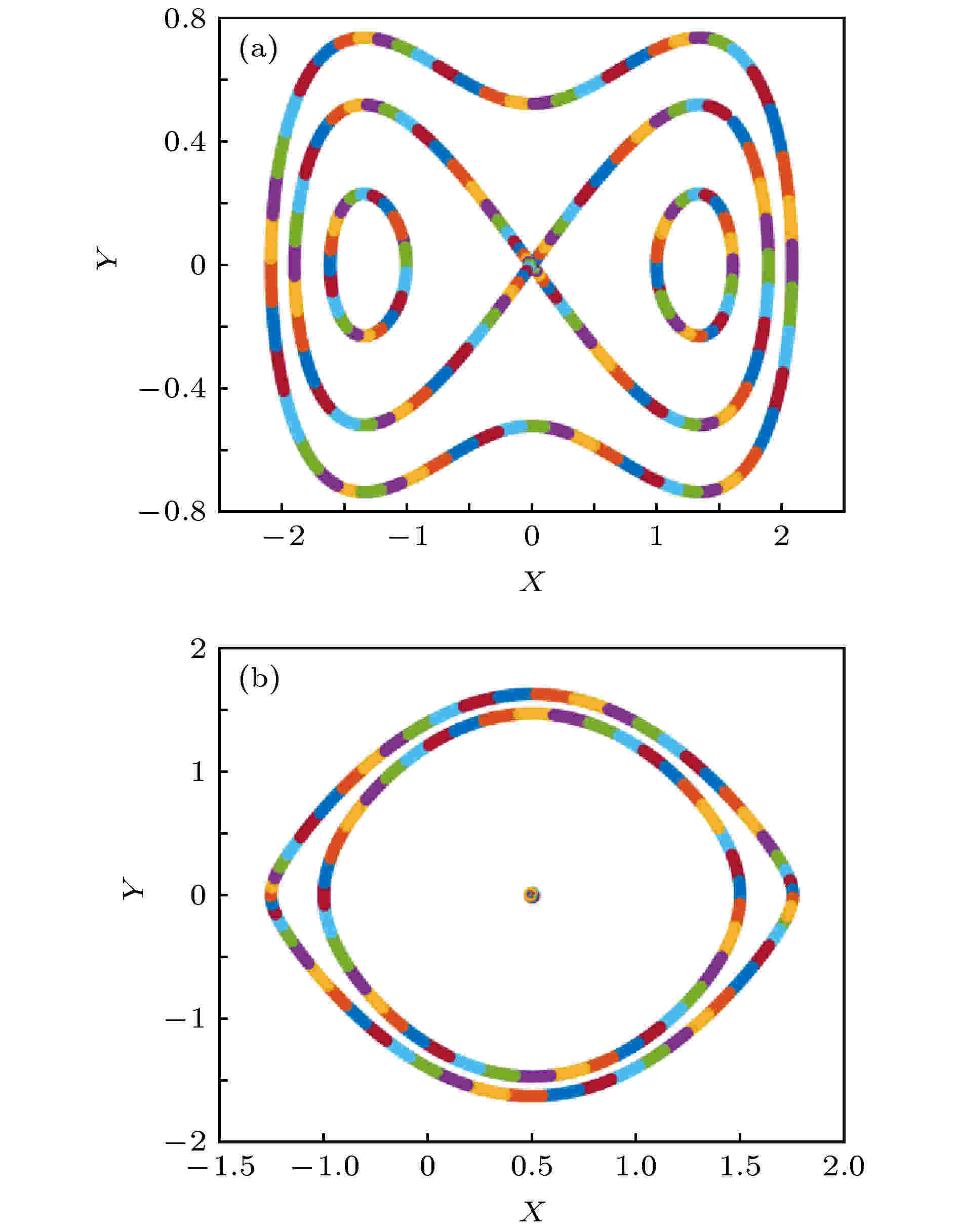
2020, 69 (1): 010502.
doi:10.7498/aps.69.20191384
Abstract +
In this paper, we study the generation mechanism of bright and dark solitary waves and rogue wave for the fourth-order dispersive nonlinear Schrödinger (FODNLS) equation, which can not only model the nonlinear propagation and interaction of ultrashort pulses in the high-speed optical fiber transmission system, but also govern the nonlinear spin excitations in the onedimensional isotropic biquadratic Heisenberg ferromagnetic spin with the octupole-dipole interaction. Firstly, via the phase plane analysis, we obtain both the homoclinic and heteroclinic orbits for the two-dimensional plane autonomous system reduced from the FODNLS equation. Further, we derive the bright and dark solitary wave solutions under the corresponding conditions, which reveals the relationship between the homoclinic (heteroclinic) orbit and solitary wave. Secondly, based on the exact first-order breather solution of the FODNLS equation over a nonvanishing background, we give the explicit expressions of group and phase velocities, and reveal that there exists a jump in both the velocities. Finally, in order to verify that the breather becomes a rogue wave at the jumping point, we obtain the first-order rogue wave solution by taking the limit of the breather solution at such point, which confirms the relationship of the generation of rogue wave with the velocity discontinuity.
2020, 69 (1): 010503.
doi:10.7498/aps.69.20191172
Abstract +
Multiple soliton solutions are fundamental excitations. There are many kinds of equivalent representations for multiple soliton solutions such as the Hirota forms, Wronskian and/or double Wronskian expressions and Phaffian representations. Recently, in the studies of multi-place nonlocal systems, we find that there are a type of novel but equivalent simple and elegant forms to describe multiple soliton solutions for various integrable systems. In this paper, we mainly review novel types of expressions of multiple soliton solutions for some kinds of nonlinear integrable systems. Meanwhile, some completely new expressions for the Sawada-Kortera equations, the asymmetric Nizhnik-Novikov-Veselov system, the modified KdV equation, the sine-Gordon equation, the Ablowitz-Kaup-Newell-Segue system and the completely discreteH1equation are firstly given in this paper. New expressions usually possess explicit full reversal symmetries including parity, time reversal, soliton initial position reversal and charge conjugate reversal. These kinds of explicitly symmetric forms are very useful and convenient in the studies on the nonlinear physical problems such as the multi-place nonlocal systems and the resonant structures.
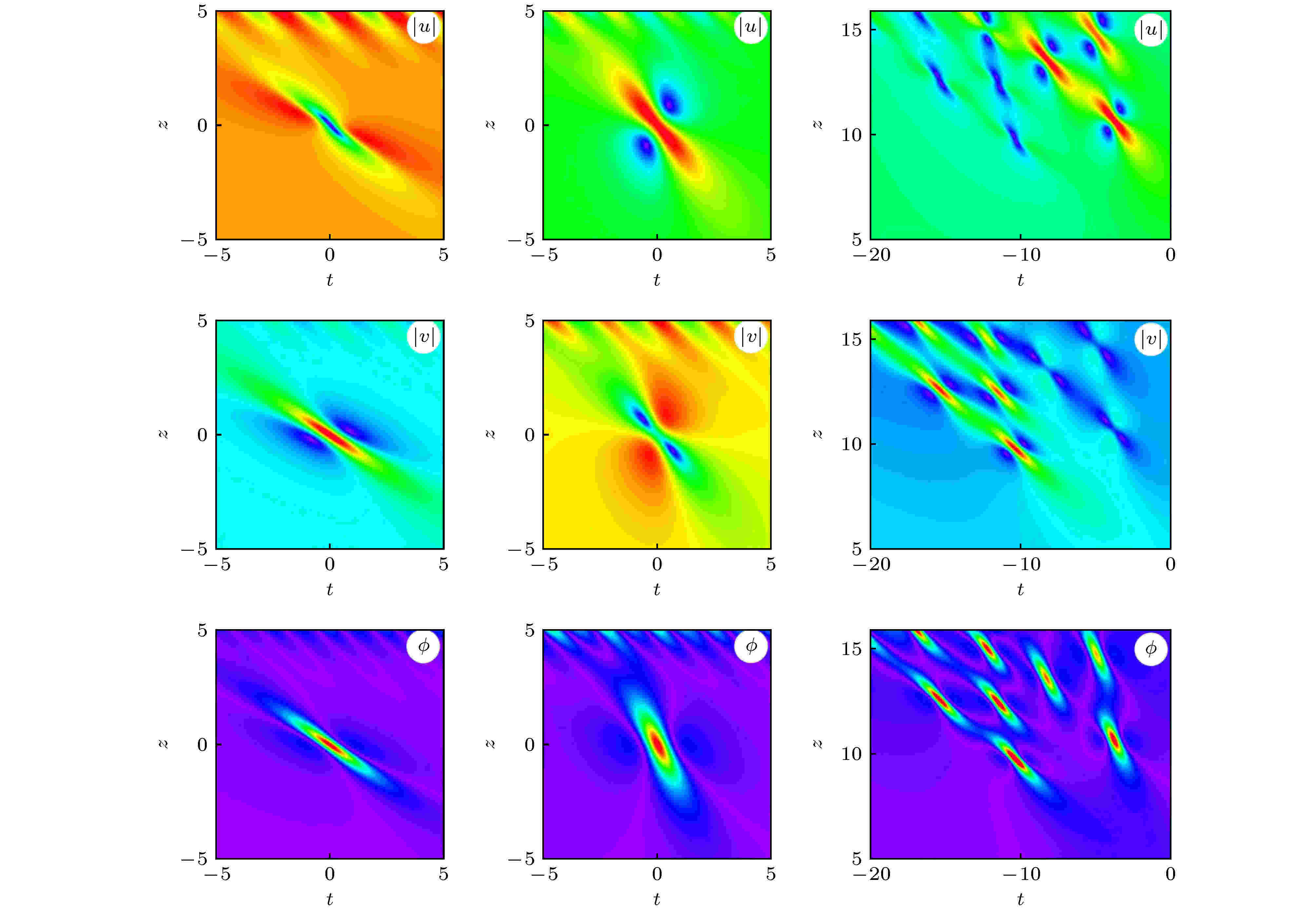
2020, 69 (1): 010504.
doi:10.7498/aps.69.20191240
Abstract +
From a microscopic perspective, the single extreme rogue wave event can be thought of as the spatiotemporally localized rational solutions of the underlying integrable model. A typical example is the fundamental Peregrine rogue wave, who in general entails a three-fold peak amplitude, while making its peak position arbitrary on a finite continuous-wave background. This kind of bizarre wave structure agrees well with the fleeting nature of realistic rogue waves and has been confirmed experimentally, first in nonlinear fibers, then in water wave tanks and plasmas, and recently in an irregular oceanic sea state. In this review, with a brief overview of the current state of the art of the concepts, methods, and research trends related to rogue wave events, we mainly discuss the fundamental Peregrine rogue wave solutions as well as their recent progress, intended for three typical integrable models, namely, the long-wave short-wave resonant equation, the three-wave resonant interaction equation, and the nonlinear Schrödinger and Maxwell–Bloch equation. Basically, while the first two models can describe the resonant interaction among optical waves, the latter governs the interaction between the optical waves and the resonant medium. For each integrable model, we present explicitly its Lax pair, Darboux transformation formulas, and fundamental Peregrine rogue wave solutions, in a self-consistent way. We confirm by convincing examples that these fundamental rogue wave solutions exhibit universality and can be applied to the multi-component or the higher-order versions of the current integrable models. By means of numerical simulations, we demonstrate as well several novel rogue wave dynamics such as coexisting rogue waves, complementary rogue waves, and Peregrine solitons of self-induced transparency.
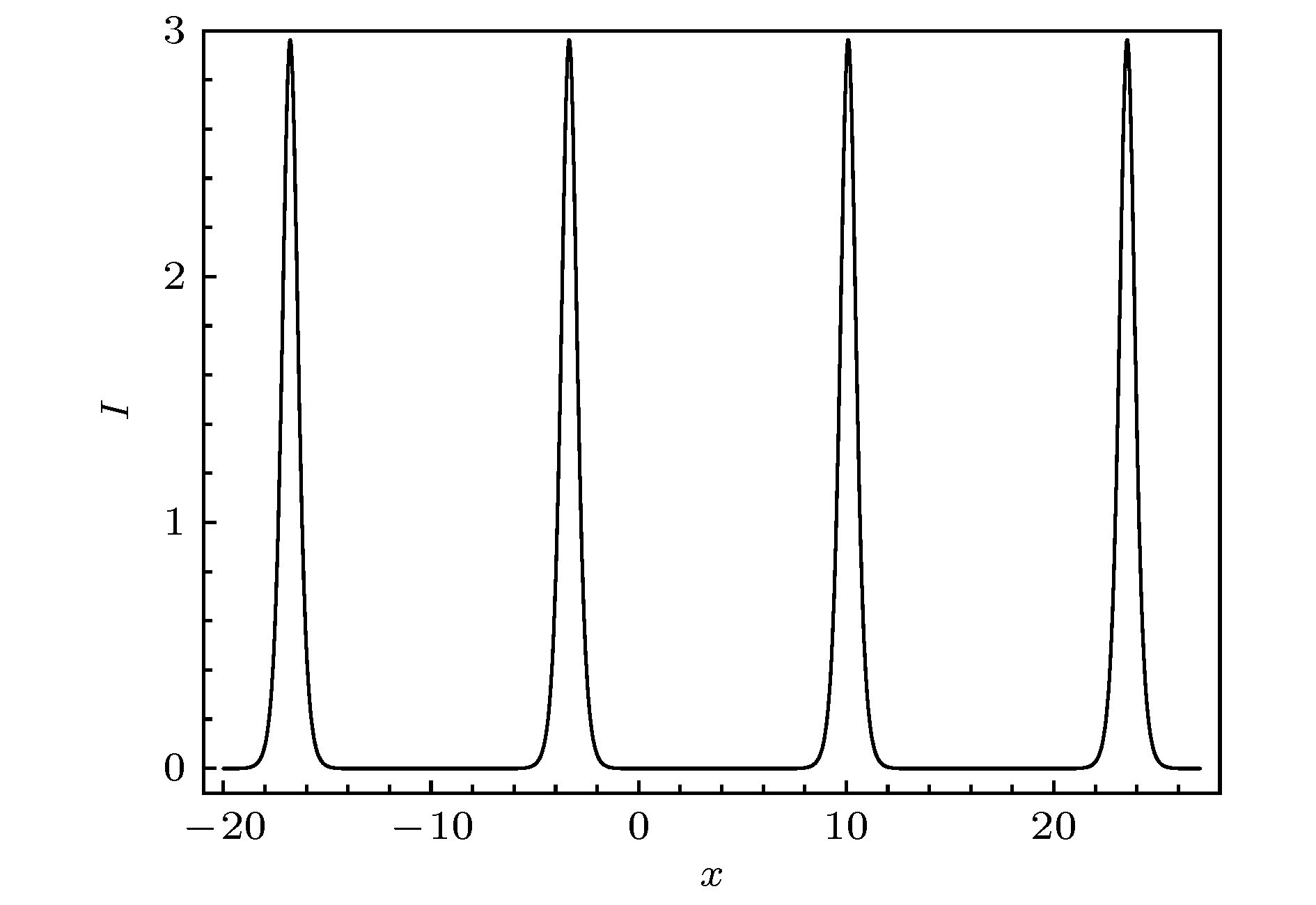
2020, 69 (1): 014208.
doi:10.7498/aps.69.20191347
Abstract +
The study on soliton molecules is one of the important topics in nonlinear science especially in nonlinear optics. The bright soliton molecules have been experimentally observed in optics, however, the dark soliton molecules have not yet been experimentally observed. Theoretically, the soliton molecules have been found for some coupled nonlinear systems. Nevertheless, the soliton molecules have not been obtained for non-coupled single component nonlinear models. In this paper, we first study the exact periodic waves (soliton lattices) and solitary waves for a nonlinear nonintegrable optical model with second and third order dispersions and high order nonlinear effects including self-steeping, Raman scattering and nonlinear dispersion. Two types of dark soliton lattice and three types of soliton lattice are explicitly exhibited for general nonintegrable system. Five types of bright (with and without gray background), dark and gray solitons can be obtained from the limit cases of the modules of the soliton lattices. For an integrable case, using a novel generalized bilinear form of a single component nonlinear system, the multi-soliton solutions are obtained and expressed by a completely new form which are invariant under the full reversal transformations such as the parity, the time reversal, the charge conjugate and the field reversal. To find soliton molecules, a novel mechanism, the velocity resonant, is proposed. Starting from the multi-soliton solutions and using the velocity resonance mechanism, the analytical expression of the dark soliton molecules can be readily obtained. For the model given in this paper, the integrable higher order nonlinear Schrodinger equation, one can proved that the interactions among the dark soliton molecules and the usually solitons are elastic. It is worth pointing out that soliton molecules can also exist in the case of nonintegrable systems.
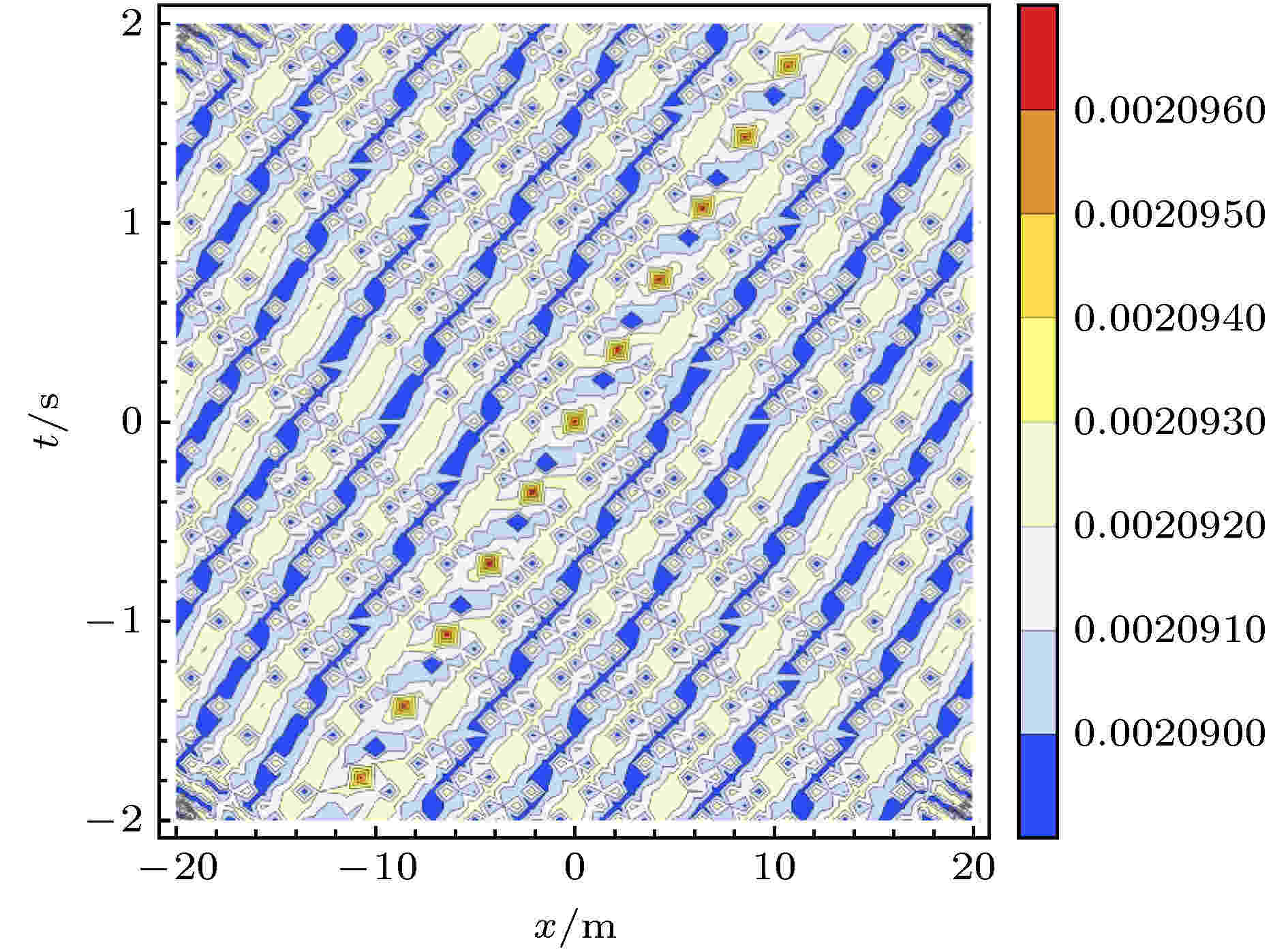
2020, 69 (1): 014701.
doi:10.7498/aps.69.20191308
Abstract +
By the reductive perturbation method, we investigate the Rogue waves in a fluid-filled elastic tube. Based on a nonlinear Schrodinger equation obtained from a fluid-filled elastic tube, the rouge wave solution in the fluid-filled elastic tube is discussed. The characteristics of a single rouge waveare studied for this system. Then, the effects of the system parameters, such as the wave number k, the parameters
$\epsilon$
, the density of the fluid, the thickness of the elastic tube, the Yang's modulus of the elastic tube, and the radius of the elastic tube on the rouge wave are also investigated. Finally, the model is applied to the blood vessels of both animal and the human to ascertain the effects of the rouge wave in different arteries and vessels. The results of the present study may have potential applications in medical science.
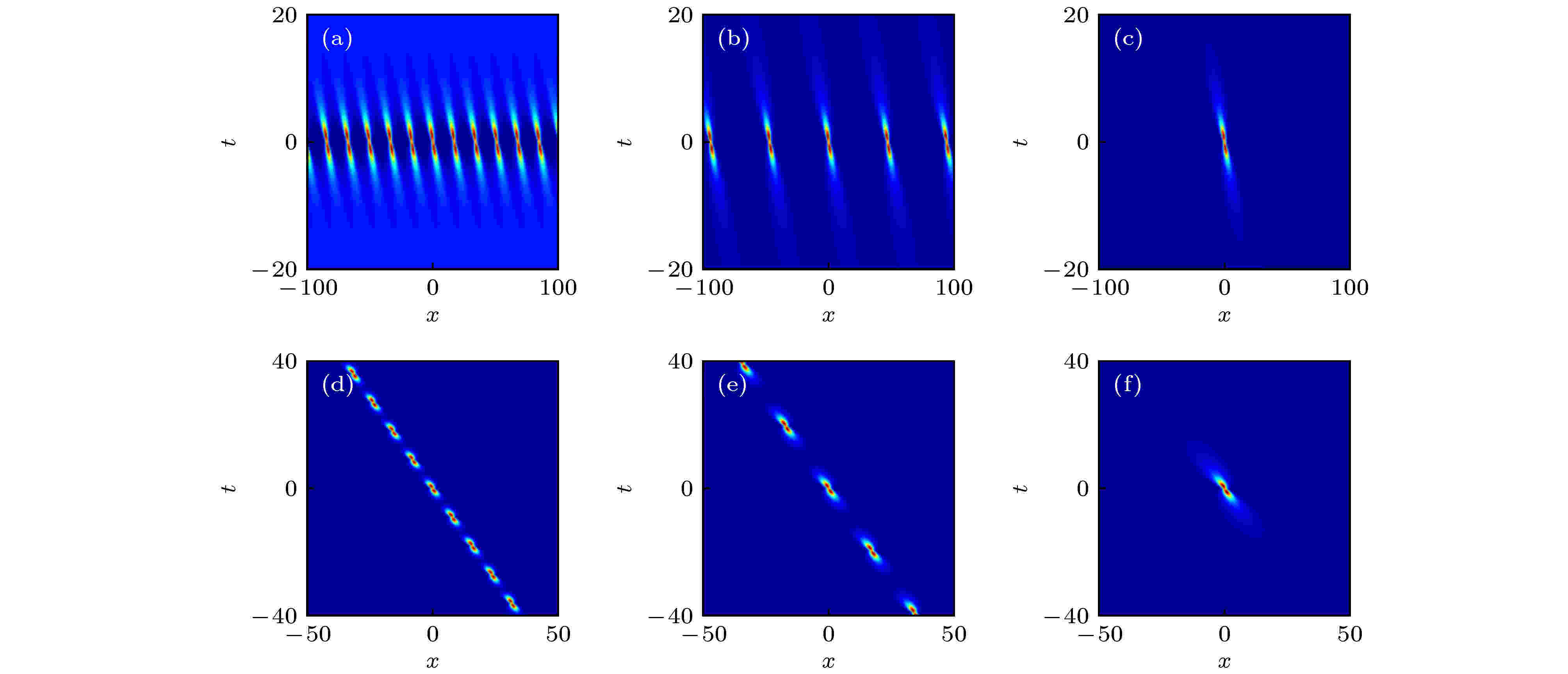
2020, 69 (1): 017501.
doi:10.7498/aps.69.20191352
Abstract +
In this paper, we introduce some new excited states of magnetization in ferromagnetic nanowires, including Akhmediev breathers, Kuznetsov-Ma soliton and rogue wave in isotropic ferromagnetic nanowires, and rogue wave in anisotropic ferromagnetic nanowires driven by spin-polarized current. The isotropic case demonstrates a spatial periodic process of a magnetic soliton forming the petal with four pieces and a localized process of the spin-wave background. In a limit case, we get rogue waves and clarify its formation mechanism. In the case of anisotropy, it is found that the generation of rogue waves mainly comes from the accumulation of energy and rapid dispersion in the center. In addition, rogue waves are unstable, the spin-polarized current can control the exchange rate of magnons between the envelope soliton and the background. These results can be useful for the exploration of nonlinear excitation in Bosonic and fermionic ferromagnet.
YOUNG SCIENTISTS' FORUM
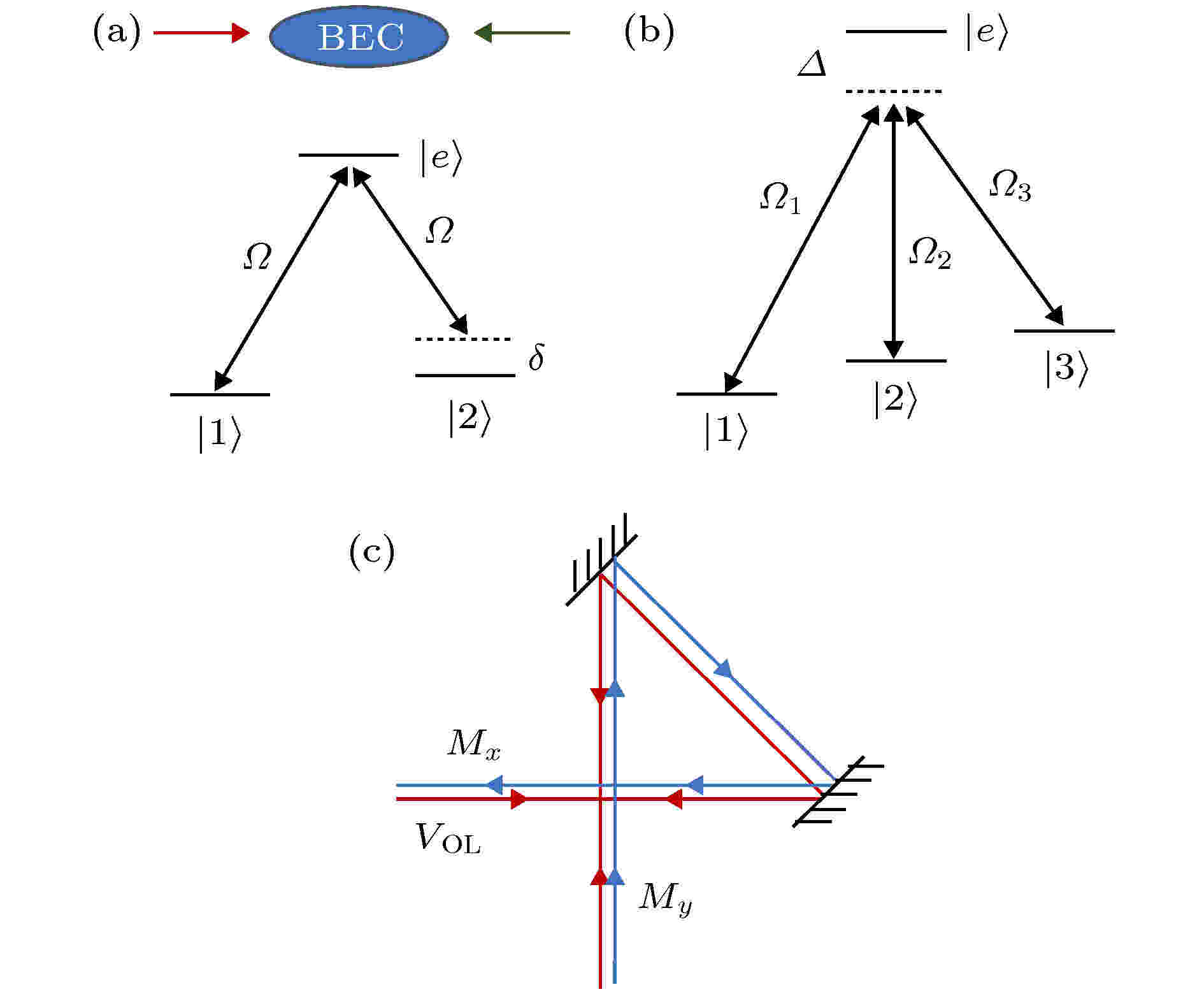
YOUNG SCIENTISTS' FORUM
2020, 69 (1): 016701.
doi:10.7498/aps.69.20191241
Abstract +
Artificial synthetic gauge field and spin-orbit coupling has been extensively studied following their experimental realization in ultracold atomic systems. Thanks for the versatile controllability, such systems not only provide possibilities to simulate and study important models in multidisciplinary fields of physics, but also work as an excellent platform to engineer novel states of matter and quantum phenomena. This paper reviews some recent progresses on the study of ultracold atomic systems with spin-orbit coupling, focusing on the effects induced by dissipation, novel interaction forms, large symmetry of spins, and long-range interactions. The investigation in these aspects is closely related to the characteristics of ultracold atomic systems, hence can bring new inspirations and perspectives on the understanding of spin-orbit coupling. In this review, we firstly investigate the appearance of a topological superradiant state in a quasi-one-dimensional Fermi gas with cavity-assisted Raman process. A cavity-assisted spin-orbit coupling and a bulk gap opening at half filling will be induced by the superradiant light generated in the transversely driven cavity mode. The topological superradiant state and the corresponding topological phase transition in the system can be driven by this mechanism. Then, symmetry-protected topological states of interacting fermions will be introduced in a quasi-one-dimensional cold gas of alkaline-earth-like atoms. Raman-assisted spin-orbit couplings in the clock states, together with the spin-exchange interactions in the clock-state manifolds will give rise to symmetry-protected topological states for interacting fermions, by taking advantage of the separation of orbital and nuclear-spin degrees of freedom in these alkaline-earth-like atoms. Furthermore, we show that an exotic topological defect, double-quantum spin vortices, which are characterized by doubly quantized circulating spin currents and unmagnetized filled cores, can exist in the ground states of SU(3) spin-orbit-coupled Bose-Einstein condensates. It is found that the combined effects of SU(3) spin-orbit coupling and spin-exchange interaction determine the ground-state phase diagram. Finally, we demonstrate that spin-orbit coupling and soft-core long-range interaction can induce an exotic supersolid phase of Bose gas, with the emergence of spontaneous circulating particle current. This implies that a finite angular momentum can be generated with neither external rotation nor synthetic magnetic field, and the direction of the angular momentum can be altered by adjusting the strength of spin-orbit coupling or interatomic interaction.
Original Articles
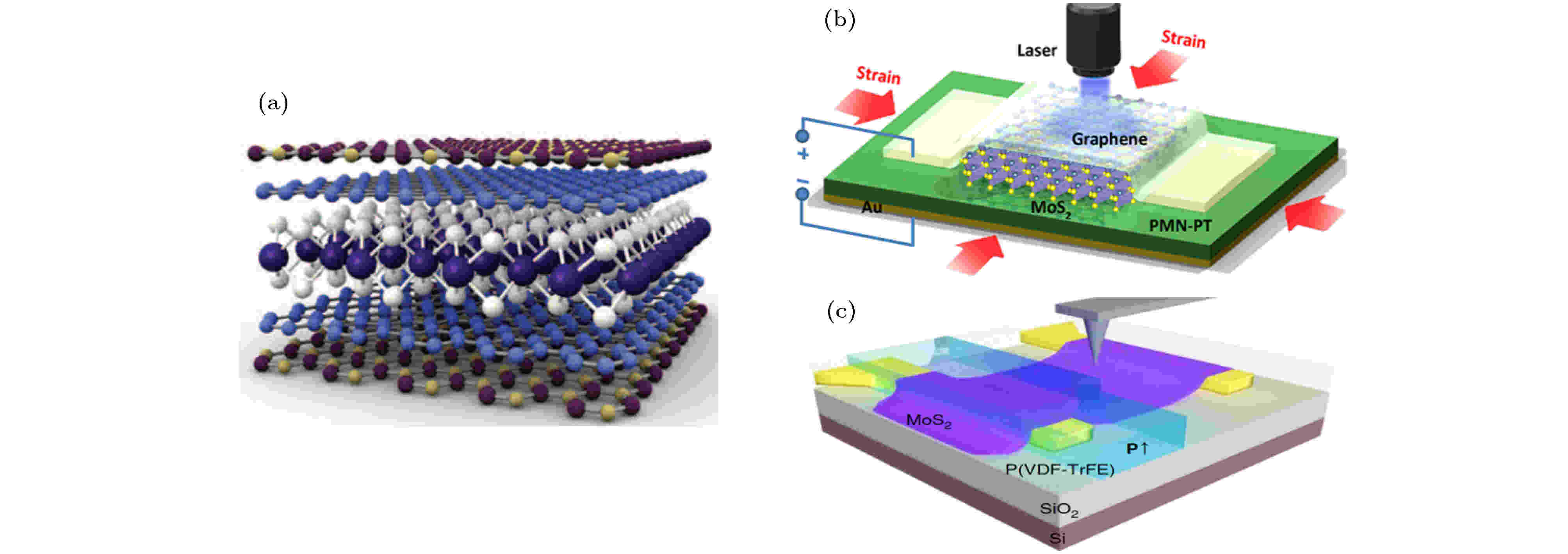
EDITOR'S SUGGESTION
2020, 69 (1): 017301.
doi:10.7498/aps.69.20191486
Abstract +
With the rapid development of microelectronic integration technology, the miniaturization, integration and multifunction of electronic devices are becoming a general trend. Two-dimensional materials are a class of layered material with atomic layer thickness, and have unique electrical, magnetic, optical and mechanical properties. The co-existence of the weak van der Waals force between layers and the strong covalent bonding within layers makes the two-dimensional material very suitable for the miniature design of new-generation multifunctional electronic devices. Two-dimensional materials, represented by graphene and transition metal chalcogenides, exhibit high mobility, adjustable energy band and high visible light transmittance, and thus having become the frontier hotspots in the field of micro-nanoscience in recent years. Synergy between two-dimensional materials and various functional materials such as SiO2insulator, semiconductor, metal and organic compound may lead to new properties and device applications, thus can deepen and expand the basic research and application of two-dimensional materials. Among them, ferroelectric materials have received much attention because of their spontaneous polarizations, high dielectric constants, and high piezoelectric coefficients. The two-dimensional ferroelectric composites well have the advantages of the two, i.e. they not only contain a variety of rich phenomena such as the magnetoelectric coupling effect, ferroelectric field effect and lattice strain effect, tunneling effect, photoelectric effect, and photoluminescence effect, but also have broad applications in devices such as multi-state memories, tunneling transistors, photoelectric diodes, solar cells, super capacitors, and pyroelectric infrared detectors, which have attracted wide concern from academia and industry. To better understand the combination of two-dimensional thin films with ferroelectric substrates and provide a holistic view, we review the researches of several typical two-dimensional film/ferroelectrics heterostructures in this article. First, two-dimensional materials and ferroelectric materials are introduced. Then, the physical mechanism at the interface is briefly illustrated. After that, several typical two-dimensional film/ferroelectrics heterostructures are mainly introduced. The ferroelectric materials including Pb(Zr1–xTix)O3, (1–x)PbMg1/3Nb2/3O3–xPbTiO3, P(VDF-TrFE), are mainly summarized, and other ferroelectric materials such as P(VDF-TrFE-CFE), BaTiO3, BiFeO3, PbTiO3, CuInP2S6, HfO2are briefly involved. The future research emphasis of the two-dimensional materials/ferroelectrics composites is also suggested at the end of the article. This review will present a significant reference to the future design of miniature and multifunctional devices.
GENERAL
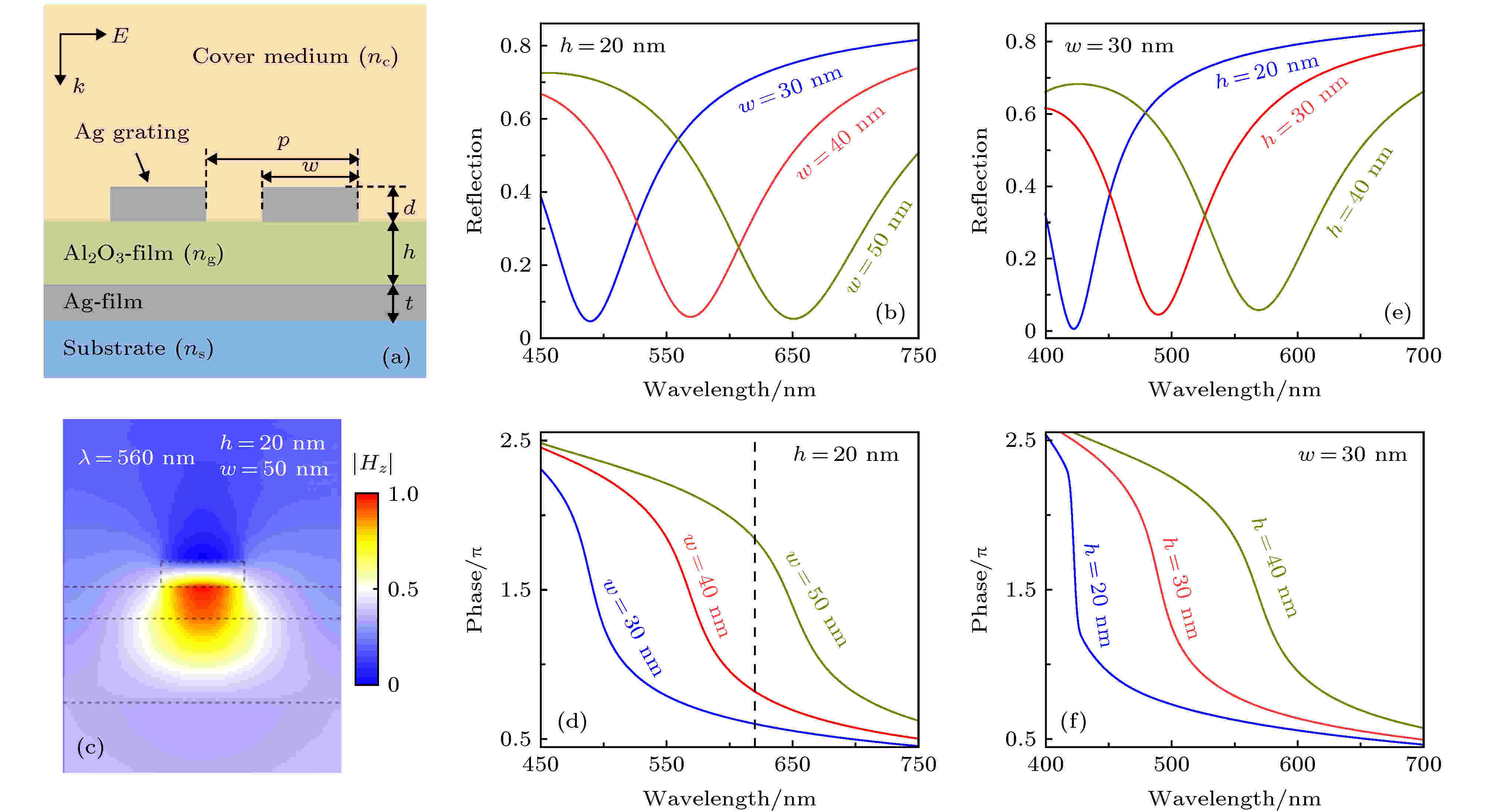
COVER ARTICLE
2020, 69 (1): 010201.
doi:10.7498/aps.69.20191225
Abstract +
In this paper, the Tamm plasmon and its interaction with excitons in a plasmon microcavity consisting of metasurface, dielectric spacer, distributed Bragg reflector (DBR) are studied. The reflection phase of light on the surface can be controlled by changing the structure parameters in the metasurface. When the thickness of the dielectric spacer layer of the microcavity structure keeps unchanged, the resonance position of the Tamm plasmon mode supported by the microcavity structure can be adjusted by varying the structure parameters of the metasurface, and thus providing more degrees of freedom for regulating the Tamm plasmon mode. In addition, by comparing the traditional metal thin film-dielectric spacer-DBR structure, we find that the introduction of metasurface and its regulation of reflection phase can make the metasurface-dielectric spacer-DBR structure support the Tamm plasmon mode resonance at the same wavelength under a smaller thickness of spacer. And combining the local characteristics of the super-surface field, the model volume of Tamm plasmon can be reduced effectively. On this basis, we compare the interaction of traditional and metasurface-based Tamm plasmon with single-layer tungsten disulfide (WS2), and find that metasurface-based Tamm plasmon can produce stronger photon-exciton coupling and obtain larger Rabi splitting.
ATOMIC AND MOLECULAR PHYSICS
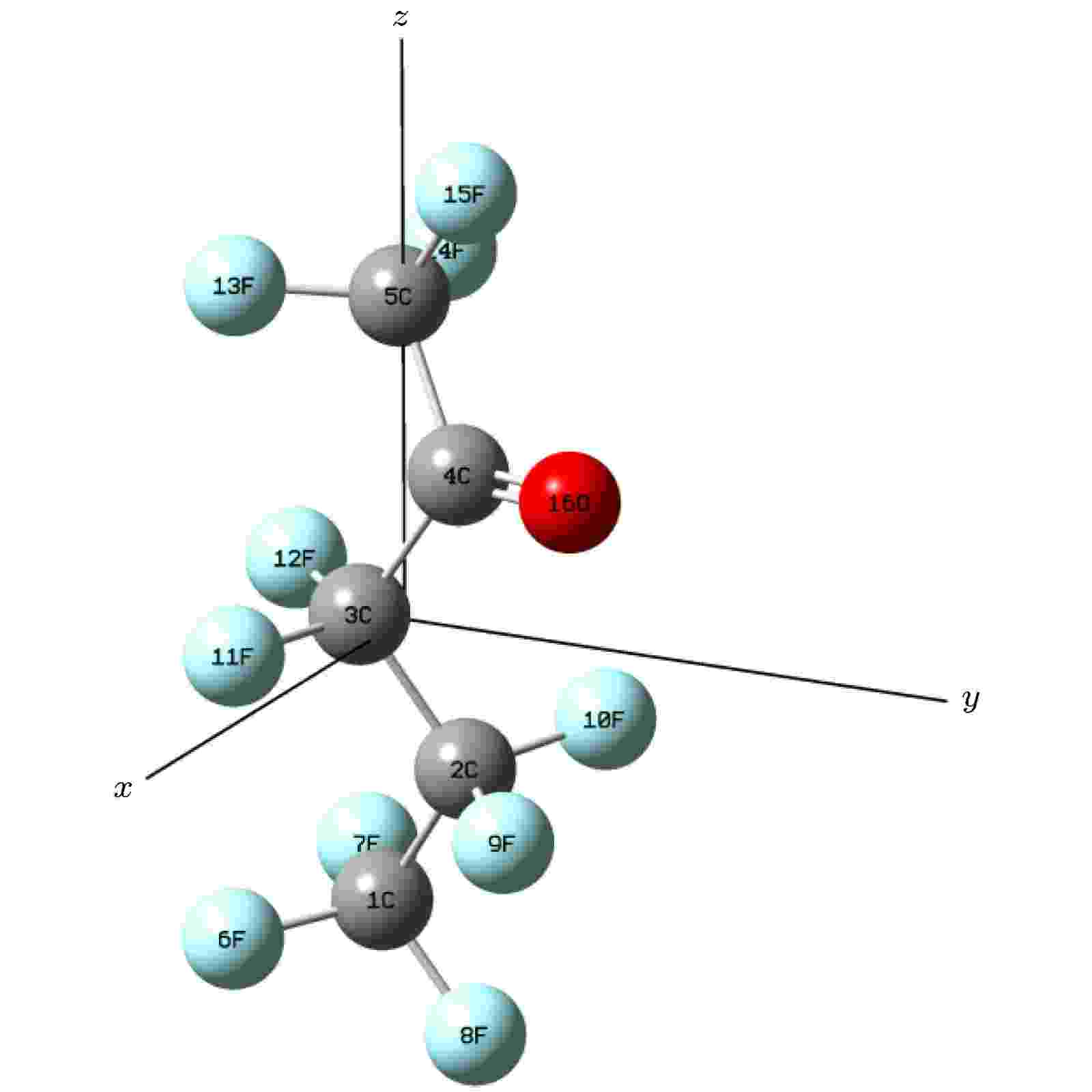
2020, 69 (1): 013101.
doi:10.7498/aps.69.20191455
Abstract +
In this paper, we use the density functional theory (B3LYP) method with 6-311g(d) basis sets to optimize the molecular structure of C5F10O and obtain the stable structure of its ground state. On this basis, the geometric characteristics, energy, frontier orbital energy levels, and infrared spectra of C5F10O under the different external electric fields (from 0 to 0.03 a.u., 1 a.u. = 5.142 × 1011V/m) are studied by the same method. Under the same basis sets, the orbital composition and excitation characteristics of C5F10O are calculated and analyzed by the TD-DFT method. The conclusions show that as the electric field increases, the bond energy of 5C—15F and 4C=16O gradually decrease, their bond lengths increase. The charge of 13F atoms changes fastest, and it is easier to lose electrons under the action of electric field force. The potential energy of the molecule increases, and the stability gradually decreases. The energy gapEGvalue continuously decreases, and the molecules are more likely to be excited to participate in the chemical reaction. In the infrared spectrum, four absorption peaks are blue-shifted, and four absorption peaks are red-shifted. The excitation characteristics of the first 8 singlet excited states of the C5F10O are identified by the hole-electron analysis method. The excitation energy of the first excited state increases slightly, and the wavelength decreases, and blue shift occurs. The excitation energy values of the other excited states decrease, their wavelengths increase, and red shifts occur. Because the electrons in C5F10O become easier to excite, the stability of the system is lower.
ELECTROMAGNETISM, OPTICS, ACOUSTICS, HEAT TRANSFER, CLASSICAL MECHANICS, AND FLUID DYNAMICS
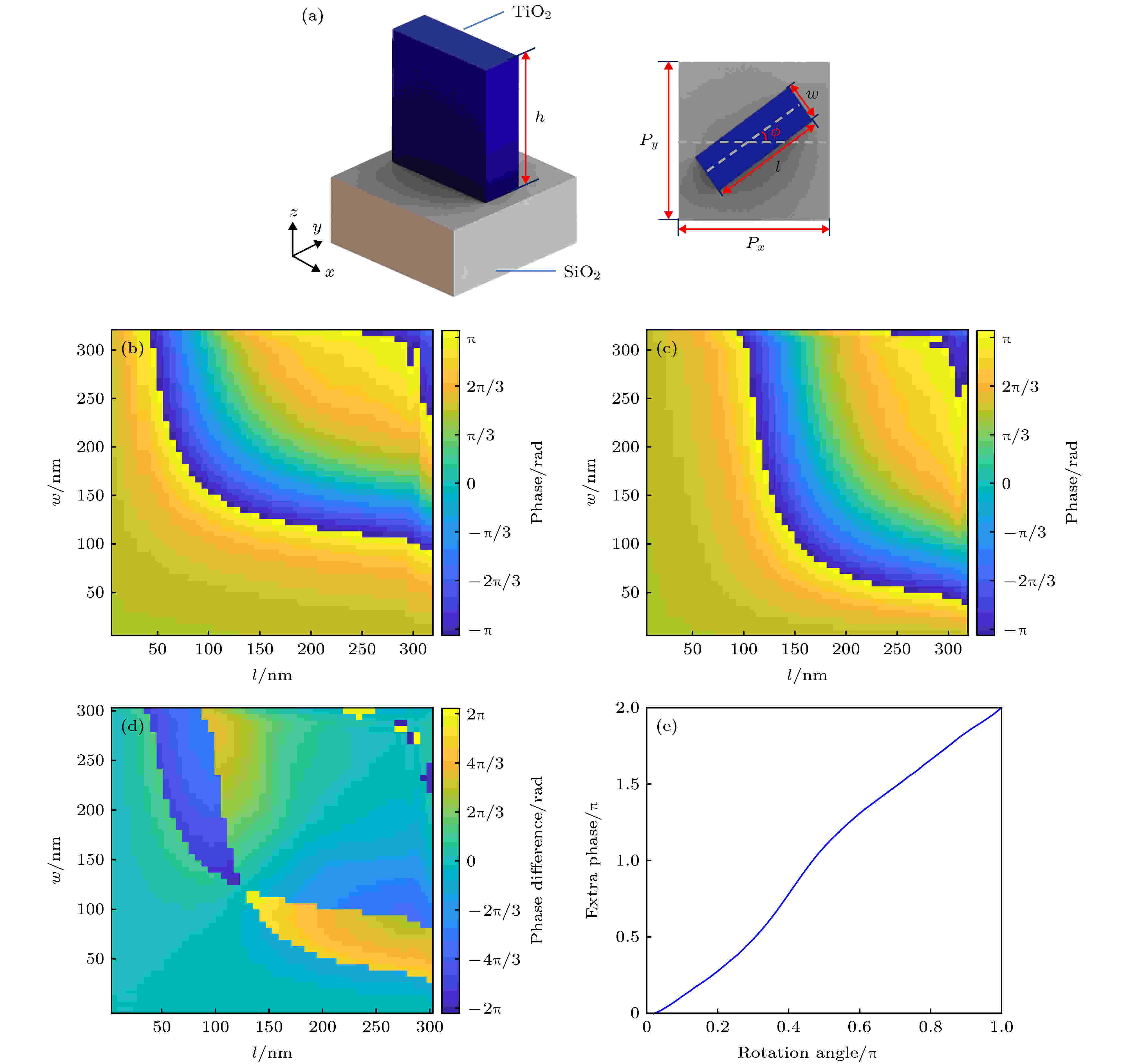
2020, 69 (1): 014101.
doi:10.7498/aps.69.20191181
Abstract +
With the rapid development of metasurface and metamaterials, the image edge detection based on the optical spatial differential calculation becomes an interesting topic in recent years. There have been a certain number of studies in this region, but most of them are applicable only to one-dimensional optical spatial differential calculation. In this work, a two-dimensional optical differentiator using Pancharatnam-Berry (P-B) phase metasurface is proposed and implemented in optical image two-dimensional edge detection. Based on the principle of the spin-dependent splitting from P-B phase devices, this metasurface is capable of separating the left-handed circularly polarized light from the right-handed circularly polarized light at a certain spatial distance. After filtering out the overlapped linear polarization, the left optical information is the result of the two-dimensional optical spatial differential. Meanwhile, the resolution of the image edge information is adjustable by changing the optic axis distribution of this two-dimensional optical differentiator. These results indicate that our P-B phase metasurface can be applied to the extraction of the optical image two-dimensional edge information, and the extracted edge information is more complete than the previous one-dimensional grating metasurface. For these advantages, this two-dimensional optical differentiator shows great potential applications in ultrafast optical calculation and image processing.
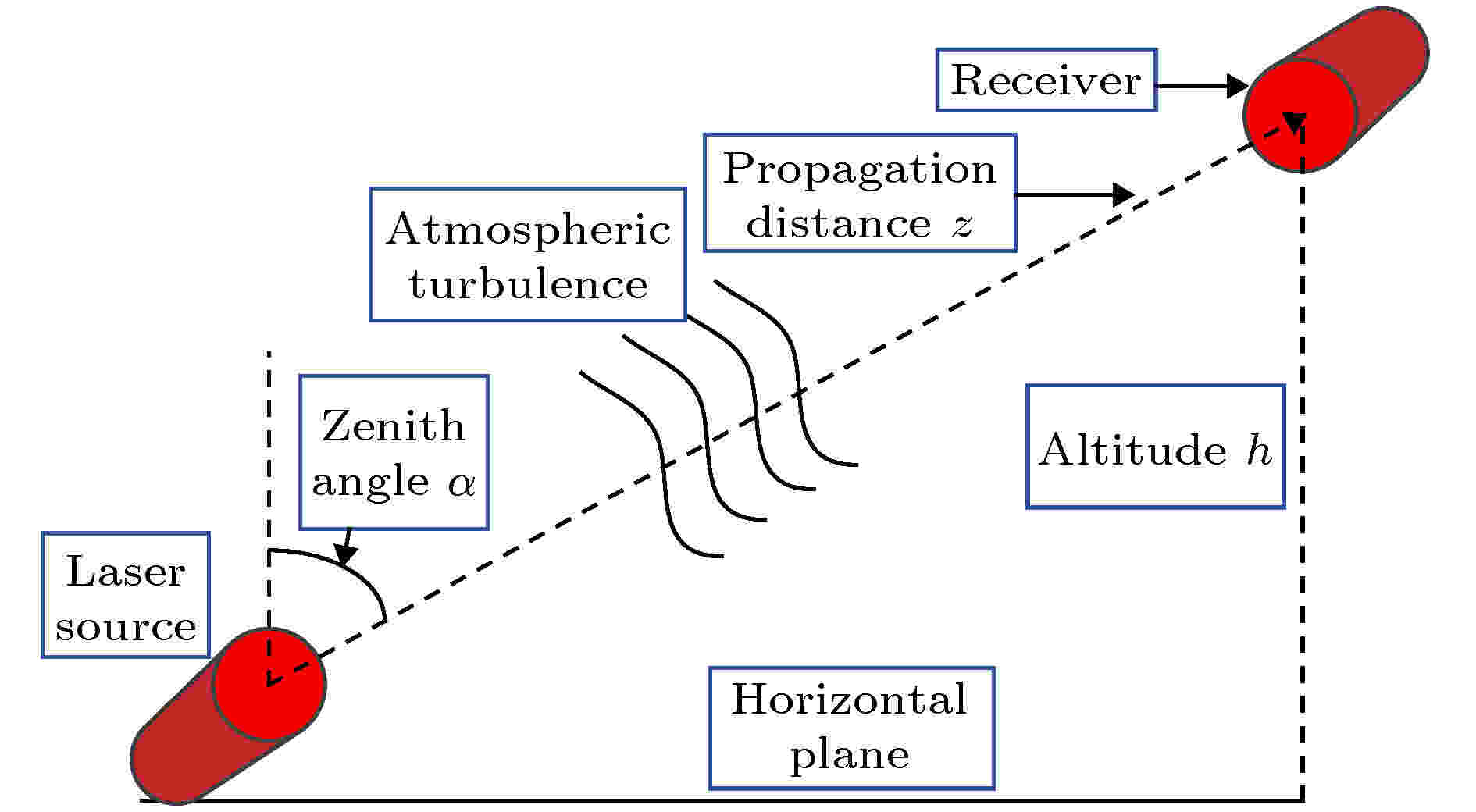
2020, 69 (1): 014201.
doi:10.7498/aps.69.20191254
Abstract +
Vortex beam has potential applications in free space optical communication because of its capacity of data transmission. Therefore, it is necessary to study the propagation characteristics of vortex beams in atmospheric turbulence. When the vortex beam propagates in the atmospheric turbulence the beam drift will occur, which has a great influence on the free space optical communication. In this paper, the beam drift of vortex beams with coma and spherical aberration transmitted in atmospheric turbulence is studied by using multi-phase screen and Fourier transform method. The numerical results show that as the transmission distance increases, the effects of both coma and spherical aberration on the beam drift are enhanced. The larger the transmission zenith angle and the coma coefficients, the greater the beam drift of the vortex beam is. However, the beam drift decreases with spherical aberration coefficient increasing. When the zenith angle and the transmission distance are both unchanged, the beam drift of the both vortex beams decrease with topological charges increasing. The influence of coma aberration on beam drift is bigger than that of spherical aberration.
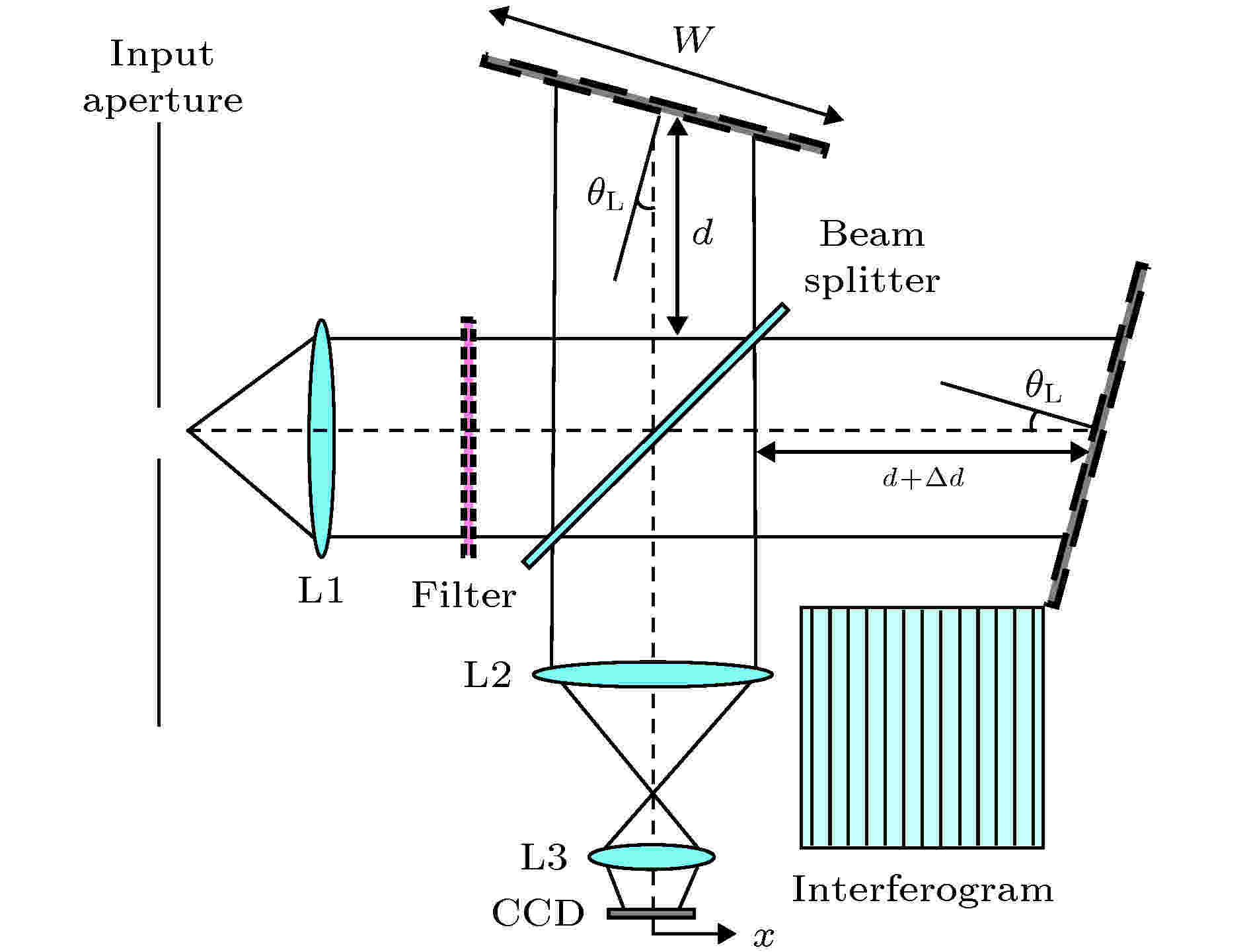
2020, 69 (1): 014202.
doi:10.7498/aps.69.20191179
Abstract +
Passive atmospheric wind detection technique retrieves atmospheric wind profile by measuring the Doppler shift of airglow emissions. Doppler asymmetric spatial heterodyne spectrometer (DASH), which is a Fourier transform spectrometer(FTS), retrieves the Doppler shift information of airglow emissions by detecting the phase shift of interferograms, and the measured phase accuracy directly affects the retrieved wind speed precision. The signal-to-noise (SNR) ratio is one of the significant indexes for evaluating the performance of wind-measuring interferometers in engineering applications. Studying the quantitative relationship between retrieved phase uncertainty and original interferogram SNR that is based on observations is quite essential for the DASH design, performance evaluation and wind profile applications. In this paper, the study is based on the noise propagation theory in FTS and DASH phase retrieval model. According to the Fourier transform relationship between time and frequency domain, we start from original interferogram expression, then we conduct the Fourier transforming, single frequency extracting, inverse Fourier transforming, phase calculating and first-order Taylor expanding, and finally we establish a theoretical relationship model between original interferogram SNR and retrieved phase uncertainty. In order to verify the theoretical relationship model, firstly, we generate 20 groups of interferograms (each group with 1000 frames) randomly with varying the 30–250 times SNR value. After removing the low frequency baseline, we calculate the phase of each interferogram by DASH phase retrieval model, and obtain the phase uncertainty by calculating standard deviation of the 512th sampling of each group interferogram. Another phase retrieval uncertainty is obtained by using the theoretical relationship model between SNR and retrieved phase uncertainty derived from this paper. Secondly, a total of 23 groups of experimental interferograms (each group with 100 frames) with different intensities are collected through the self-developed DASH with a center wavelength of 632.8 nm, basic optical path difference of 50 mm, spectral resolution of 0.78 cm−1. Combining physical characteristics of shot noise and DASH parameters, interferogram SNR of each frame is calculated. We calculate phase uncertainty of experimental data through the two methods mentioned above. The results from the two different calculation methods are compared with each other to determine whether the conclusion is correct. In order to improve the accuracy of phase calculation, three lines are averaged as input to reduce the random error. The average residual between the two methods is only 0.03 mrad, the high consistency of the results indicates that the theoretical relationship model between SNR and retrieved phase uncertainty for DASH is correct. The phase uncertainty can be evaluated by interferogram SNR directly in engineering, which provides a theoretical basis for optimizing the interferometer design.
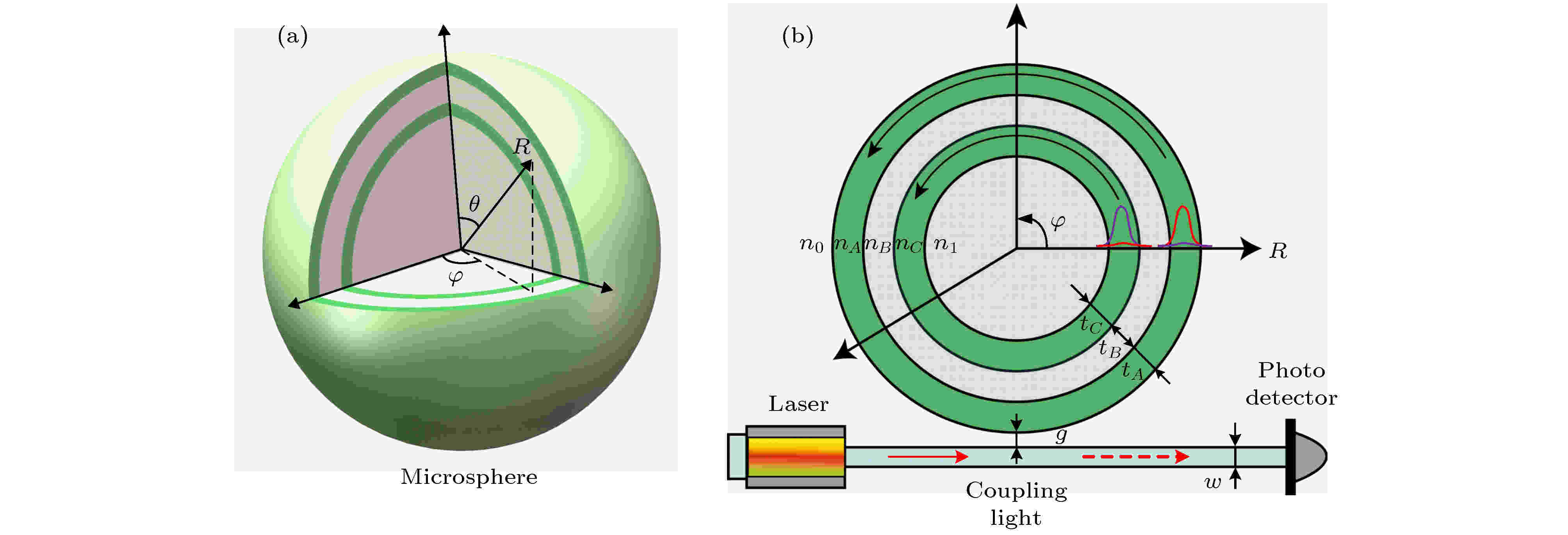
2020, 69 (1): 014203.
doi:10.7498/aps.69.20191265
Abstract +
Optical microcavity has an important and promising application in high sensitivity sensing, but thermal drift hinders its practical use. In this study, we propose a triple-layer-coated microsphere resonator, which has a high sensitivity in refractive index sensing with low thermal drift. The refractive indexes of the three layers from the inside to the outside are high, low, and high, respectively. The two high refractive index layers can support their own whispering-gallery modes, called the inner mode (IM) and the outer mode (OM). We study the performance of IM and OM with waveguide coupling in refractive index sensing and temperature sensing. The results show that when the thickness of the middle layer is 550 nm, the refractive index sensitivity of IM and OM will be 0.0168 nm/RIU, 102.56 nm/RIU, and the temperature sensitivity will be –19.57 pm/K and –28.98 pm/K, respectively. The sensing is carried out by monitoring the difference in resonant wavelength between IM and OM and the sensing characteristics are optimized by adjusting the thickness of the middle layer. Further, when
${t_B}$
= 400 nm, the refractive index sensitivity can arrive at 75.219 nm/RIU, the detection limit can reach 2.2 × 10–4RIU, and the thermal drift is reduced to 3.17 pm/K, thereby eliminating the effect of thermal drift to a great degree. This study provides the guidance for designing and improving the microsphere refractive index sensors.
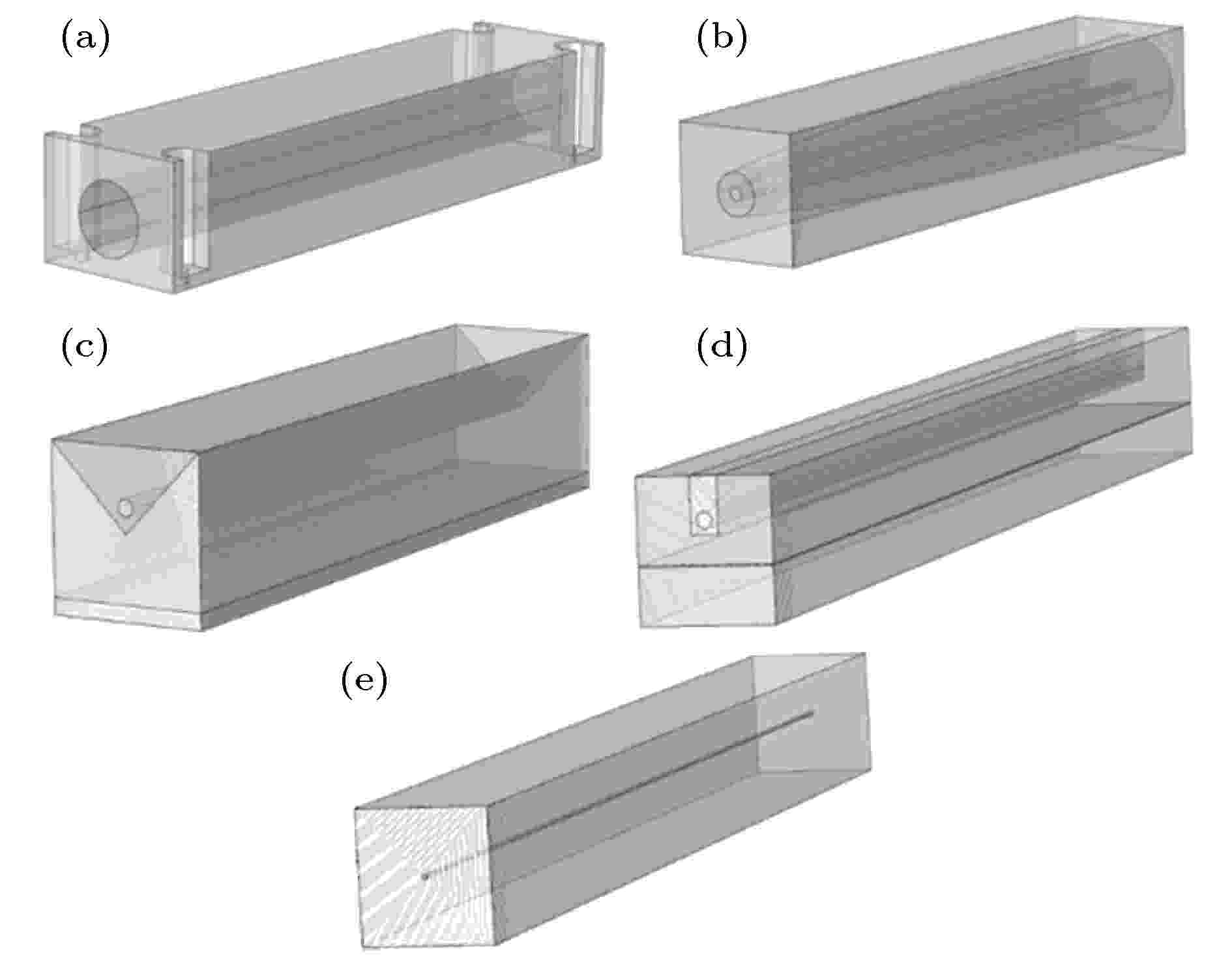
2020, 69 (1): 014204.
doi:10.7498/aps.69.20191093
Abstract +
In the process of eliminating the residual pump light and high-order laser light, the cladding power stripper (CPS) generates abundant heat, which can affect the performance of the fiber laser system due to the photothermal conversion. Hence the efficient dissipation of thermal energy becomes a current research focus. In this paper, the five kinds of existing CPSs are simulated and compared with the results in the literature. It is found that the surface-volume ratio between the heat source and the heat transfer medium can be effectively increased by changing the shape of the polymer filling hole when the CPS is made by the high refractive index polymer method, thus reducing the temperature peak and valley value of the CPS. Besides, the heat distribution uniformity of CPS can be improved by combining the high refractive index polymer method with the acid corrosion method to prepare the two-section fiber cladding structure with uneven thickness. According to the above results, a novel CPS structure is proposed and its thermal effect is studied. The results show that when the cladding light power is 150 W, the temperature peak value of the CPS is 298 K, the temperature valley value is 293 K, and the temperature difference is 5 K. Comparing with the above five CPSs, the peak temperature is reduced by up to 11.3%, and the valley temperature is reduced by up to 8.4%, the temperature difference is reduced by up to 87.5%, which proves that the novel CPS structure can effectively suppress the temperature rising and have excellent heat distribution uniformity.
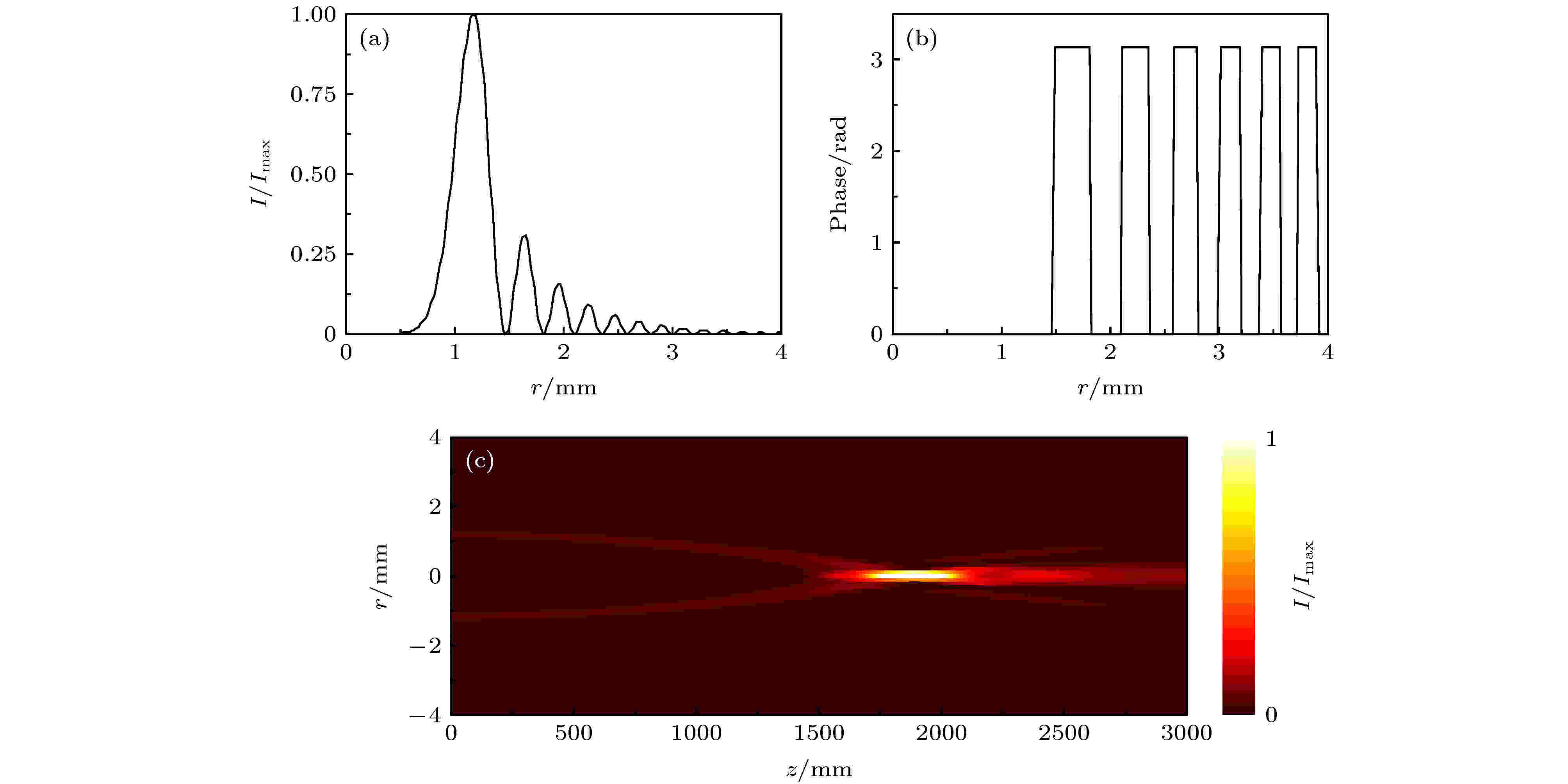
2020, 69 (1): 014205.
doi:10.7498/aps.69.20191088
Abstract +
A scheme for forming high-quality circular Airy beams inside the laser resonator is presented theoretically. The desired circular Airy beam can be generated when the common reflective mirror is replaced by a designed diffractive optical element. The mode generated in the proposed cavity can be stimulated by using the so-called eigenvector method. The calculated results show that the parameters of the beams can be controlled by changing the phase distribution of the diffractive optical element. The loss of the generated mode is very low, which is close to that of the fundamental Gaussian mode. The purity of the generated mode is very high, which is much better than that from the phase-only encoding method in Fourier space. The phase distribution of the diffractive optical element needs designing for a fixed resonator length. In practice, the real resonator length may not be equal to the designed resonator length. Thus, the influence of the alignment error of the resonator length is discussed in detail. The results show that the diffraction loss of the proposed system is still very small even when the error reaches up to 2 mm. Meanwhile, the purity of the generated mode decreases little. Then, the influence of etching depth errors and the decenter of the reflective mirrors are discussed in detail. Here we assume that the fluctuations are randomly distributed. The value of the maximum fluctuation is used to represent the etching depth error degree. The results show that the diffraction loss of the proposed system is more sensitive to production error, and the purity of the generated mode is more sensitive to alignment error. Thus, we estimate that the maximum etching depth error should be less than six percent of the wavelength, and the vertical distance between the centers of the two reflective mirrors should be less than 7 μm if one wants to obtain high-quality CAB with high efficiency. The requirements for precision are acceptable for existing microfabrication and operation technologies.
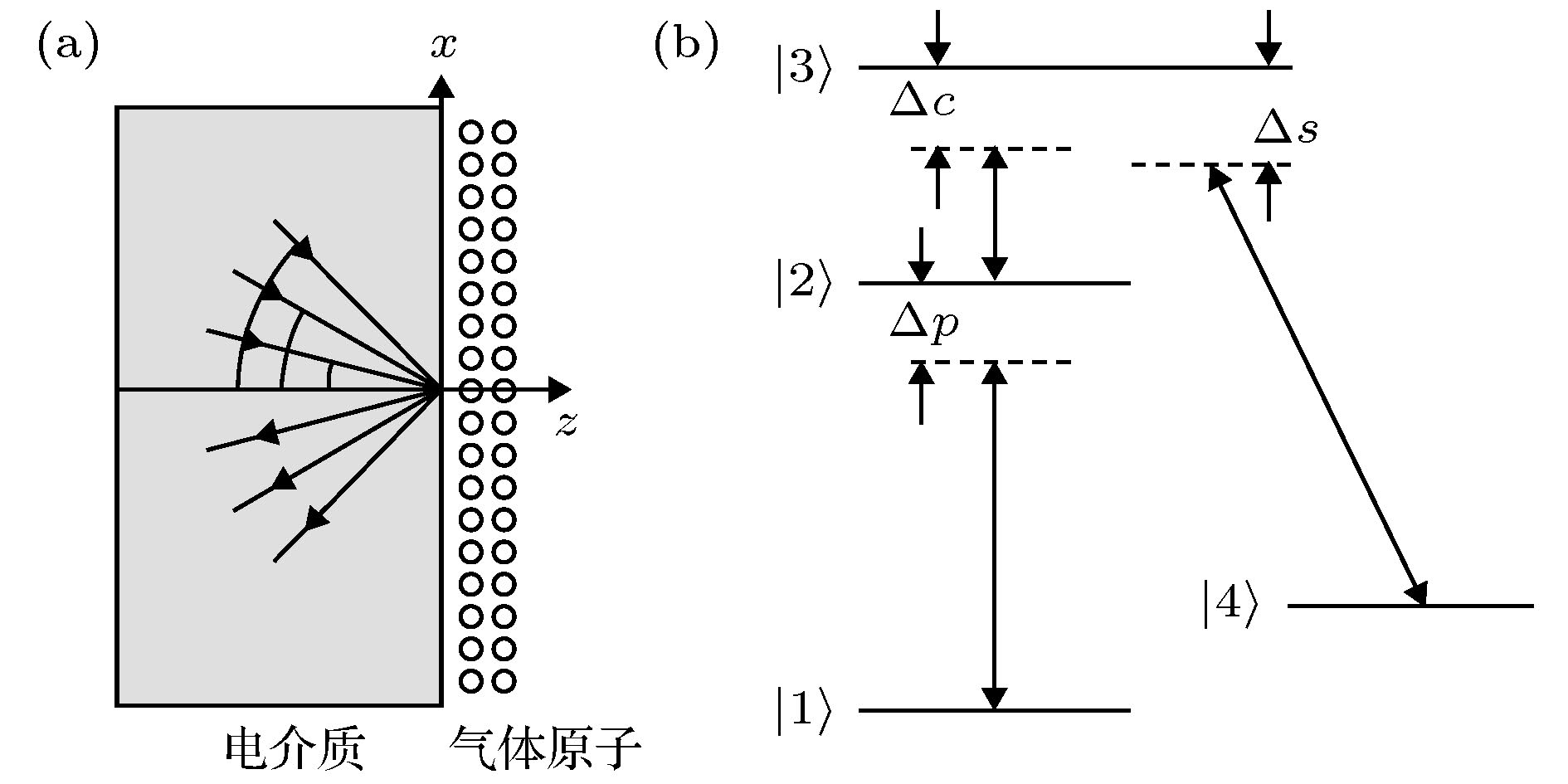
2020, 69 (1): 014206.
doi:10.7498/aps.69.20191099
Abstract +
Selective reflection (SR) from the interface between transparent medium and dilute vapour is caused by the atomic vapor near the interface. The sub-Doppler structure in SR is due to the deexcitation caused by the collision between atomic vapor and the wall. Beacuse the interaction region between atomic vapor and incident light is on the order of a few hundred nanometers, SR has low optical loss and high spatial resolution. The experimental device of SR is simple. Because of the above characteristics, the SR has been widely studied and applied. The nonlinear SR spectrum of quasi lambda-type four-level system at gas-solid interface is studied theoretically in this paper. By sloving the density matrix equations, the approximate analytic solution of the matrix element associated with the probe field is obtained at normal incidence when the intensity of the probe field is very weak. The effect of the Rabi frequency, the detuning of the signal field and the detuning of the coupling field on the lineshape are analyzed by numerical simulation, respectively. Three peaks and two transparent windows appear in SR spectrum when the detuning of coupling field and signal field are both zero. The middle peak is generated due to the participation of signal field, and the other two peaks are caused by the other two fields. The linewidth and the amplitude of the middle peak can be changed by varying the Rabi frequency of signal field, and the other two peaks have little effect on the Rabi frequency of signal field. The signal generated due to the participation of signal field can be transformed from peak to transparent window when the detuning value of the signal field is equal to the Rabi frequency of coupling field. When the detuning value of the signal field is not equal to the Rabi frequency of coupling field, a dispersion-like signal between reflection peak and transparent window is generated due to the participation of signal field. The position of peak and transparent window can be manipulated by controlling the detuning value of the coupling field. When the detuning value of coupling field decreases from zero, three peaks all shift to red detuning direction. When the detuning value of coupling field is blue-detuned and increases, three peaks all shift to blue detuning direction. The numerical results can be explained by using the various electric transition pathways and dressed state theory. This study is helpful in investigating quantum coherence and dynamic process of atoms at gas-solid interface.
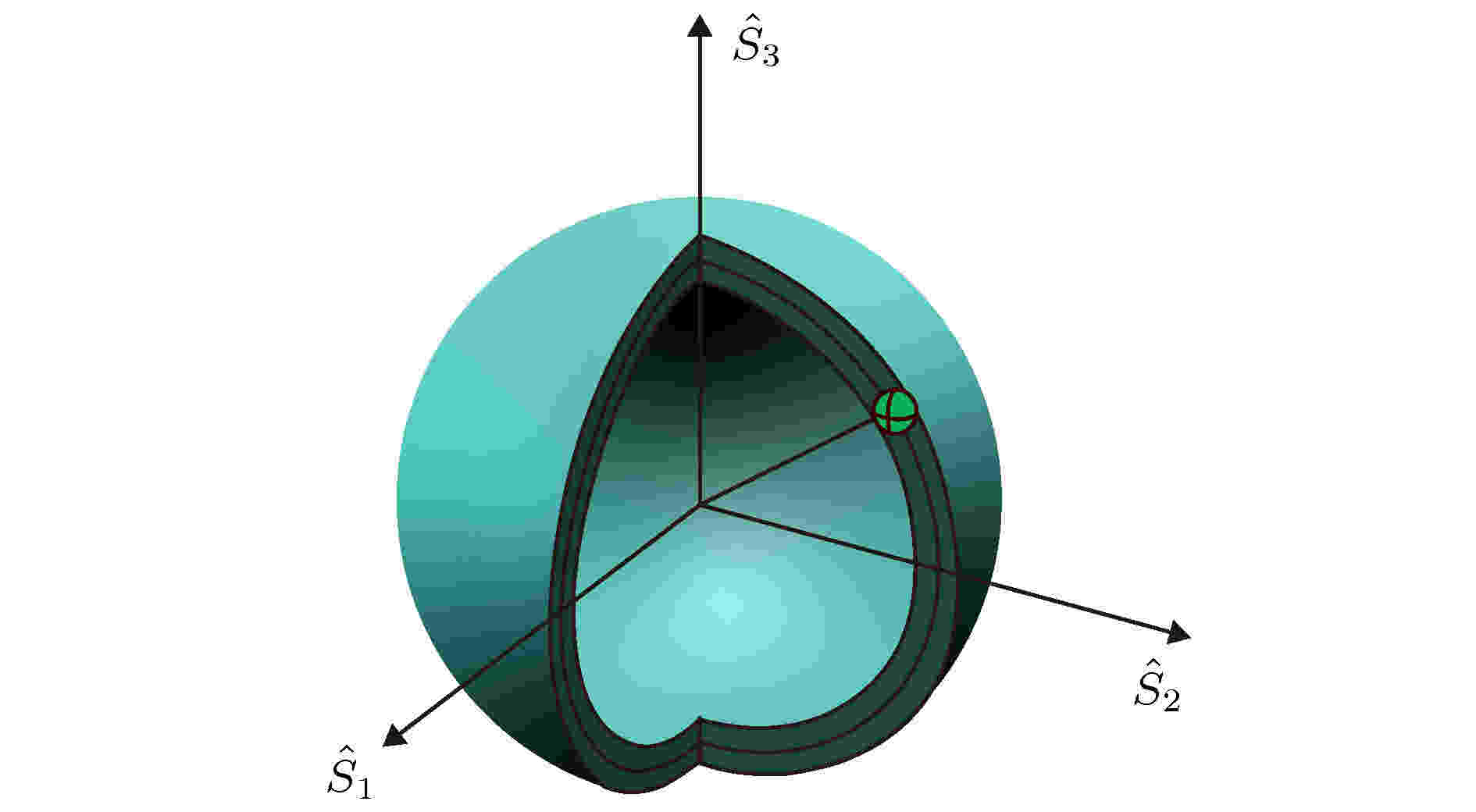
EDITOR'S SUGGESTION
2020, 69 (1): 014207.
doi:10.7498/aps.69.20191009
Abstract +
Quantum light field is very important source in quantum optics and quantum precision measurement, and the generation of quantum state of light is significant in quantum storage, quantum metrology and studying the interaction between nonclassical light and matter. The polarization squeezed light near the atomic transition has great potential applications in the precise measurement of magnetic field as its Stokes parameter’s noise is less than the standard quantum limit (SQL). Therefore, it is very important to generate the polarization squeezed light at atomic transition. We report in this paper the experiment on generating the bright polarization squeezed light at cesium D2line based on an optical parametric amplifier (OPA). The experimental system includes the following three parts: 1) a second harmonic generator (SHG), 2) an OPA, and 3) a detection system. The OPA has a similar structure to the SHG system with four-mirror ring cavity in which only the fundamental wave is resonant. A nonlinear type-I periodically-poled KTiOPO4 (PPKTP) crystal with a size of 1 mm × 2 mm × 20 mm is placed in the center of the cavity waist and its temperature is precisely controlled. The OPA is pumped by the 426 nm blue light which is generated by SHG and this OPA is operating below the threshold. The squeezed light at cesium D2line is produced when the crystal temperature is at its optimum phase-matching temperature and the OPA cavity is stabilized based on resonance. The generated squeezed light is combined with the coherent light on a polarizing beam splitter (PBS) to obtain the polarized squeezed light for either
${\hat S_2} $
or
${\hat S_3} $
of the Stokes parameter by controlling the type of squeezed light (parametric amplification or de-amplification) and the relative phase (0 or π/2) of two beams. And for
${\hat S_1} $
, the amplitude-squeezed light (corresponding to parametric de-amplification) is the
${\hat S_1} $
squeezed light. The maximum squeezing of 4.3 dB (actually 5.2 dB) is observed in a bandwidth range of 2-10 MHz. At present, the squeezing is mainly limited by the escape efficiency of OPA and the detection efficiency, and the OPA escape efficiency is mainly limited by the blue-light-induced loss of PPKTP crystal and the thermal effect of crystal. In the optical atomic magnetometer, increasing the signal-to-noise ratio (SNR) of the system can effectively improve the sensitivity of the magnetic field measurement. This bright polarization squeezed light is expected to be used in the optical cesium atomic magnetometer to improve the sensitivity of the magnetometer.
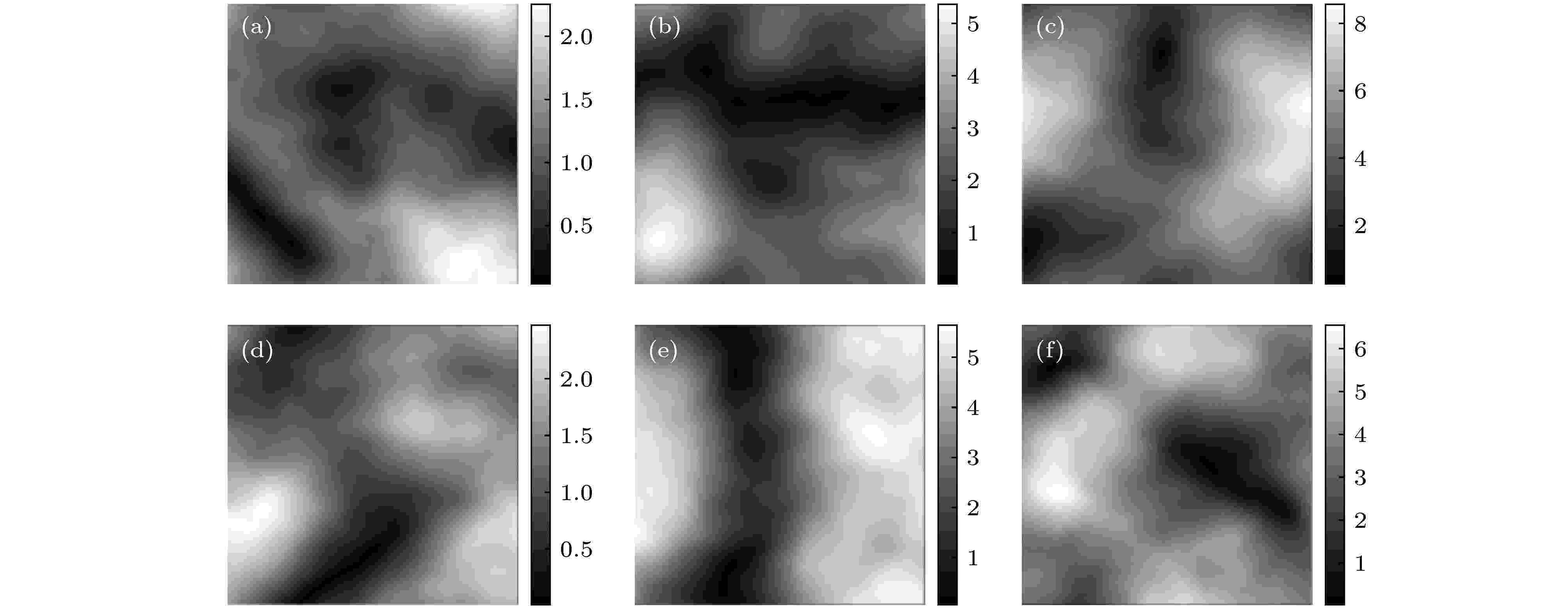
2020, 69 (1): 014209.
doi:10.7498/aps.69.20190982
Abstract +
When a light beam transmits in free space, it is easily affected by atmospheric turbulence. The effect on transmitted light is equivalent to adding a random noise phase to it, which leads its transmission quality to deteriorate. The method of improving the quality of transmitted beams is usually to compensate for the phase distortion at the receiver by adding reverse turbulence phase, and the premise of this method is to obtain the turbulence phase carried by the distorted beam. The adaptive optics system is the most common way to extract the phase information. However, it is inefficient to be applied to varying turbulence environments due to the fact that a wave-front sensor and complex optical system are usually contained. Deep convolutional neural network (CNN) that can directly capture feature information from images is widely used in computer vision, language processing, optical information processing, etc. Therefore, in this paper proposed is a turbulence phase information extraction scheme based on the CNN, which can quickly and accurately extract the turbulence phase from the intensity patterns affected by atmosphere turbulence. The CNN model in this paper consists of 17 layers, including convolutional layers, pooling layers and deconvolutional layers. The convolutional layers and pooling layers are used to extract the turbulent phase from the feature image, which is the core structure of the network. The function of the deconvolutional layers is to visualize the extracted turbulence information and output the final predicted turbulence phase. After learning a huge number of samples, the loss function value of CNN converges to about 0.02, and the average loss function value on the test set is lower than 0.03. The trained CNN model has a good generalization capability and can directly extract the turbulent phase according to the input light intensity pattern. Using an I5-8500 CPU, the average time to predict the turbulent phase is as low as s under the condition of
$C_{{n}}^2 = 1 \times {10^{ - 14}}\;{{\rm{m}}^{ - 2/3}}$
,
$ 5 \times {10^{ - 14}}\;{{\rm{m}}^{ - 2/3}}$
, and
$1 \times {10^{ - 13}}\;{{\rm{m}}^{ - 2/3}}$
. In addition, the turbulence phase extraction capability of CNN can be further enhanced by improving computing power or optimizing model structure. These results indicate that the CNN-based turbulence phase extraction method can effectively extract the turbulence phase, which has important application value in turbulence compensation, atmospheric turbulence characteristics research and image reconstruction.
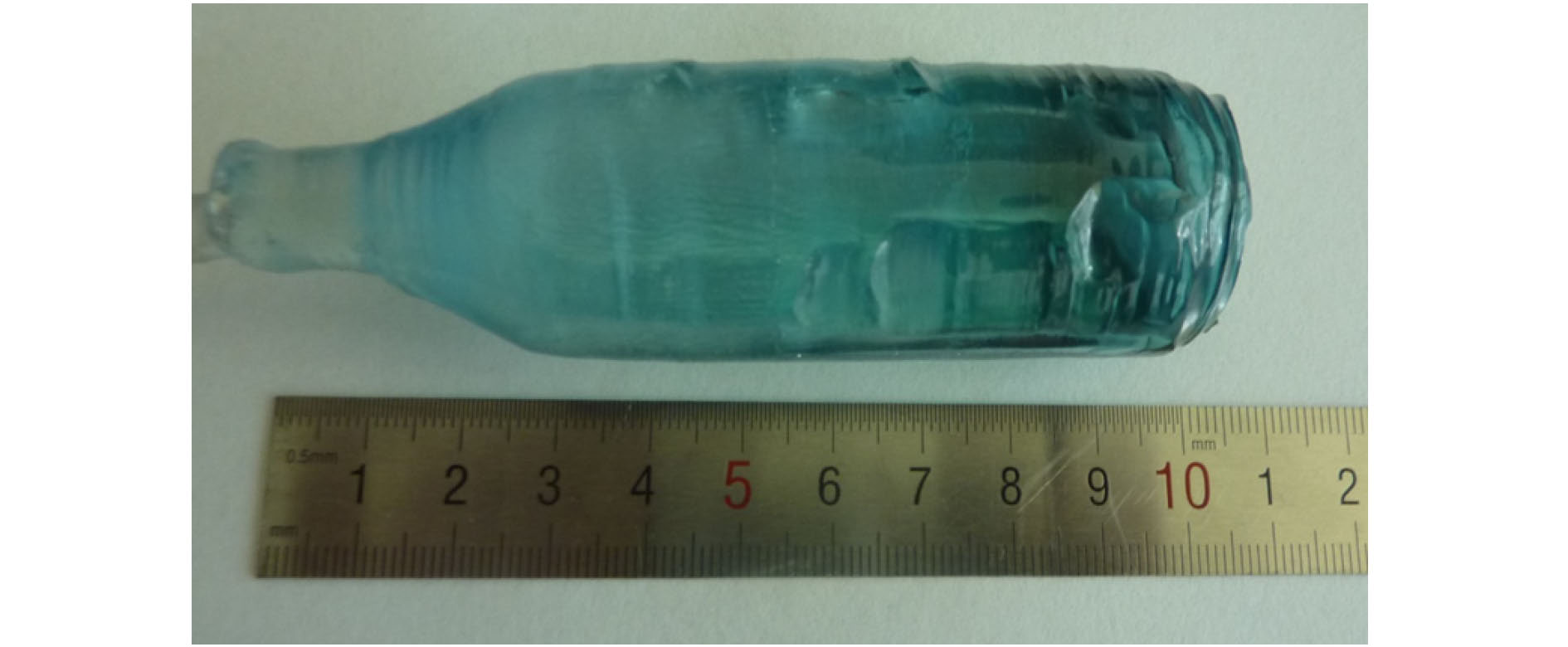
2020, 69 (1): 014210.
doi:10.7498/aps.69.20191150
Abstract +
The melting point of Ti:MgAl2O4crystal is as high as 2130 °C, it is a challenge to obtain a large-sized and high-quality laser crystal. By optimizing the crystal growth process, Ti:MgAl2O4crystal with a size of 30 mm× 70 mm is successfully grown by the Czochralski method under the condition of weak reducing atmosphere. The X-ray diffraction pattern is studied, and the x-ray rocking curve indicates that the grown crystal has a high crystalline quality in terms of the lower full width at half maximum(FWHM) intensity, which provides a material basis for the next laser output experiment. In a range of 100–1000 cm–1, there are four Raman vibration peaks located at 312, 410, 675 cm–1and 771 cm–1respectively. The grown crystal has an absorption cutoff range of 250–318 nm and two wide absorption bands of 395–495 nm and 550–1100 nm. Excited by 271 nm, the grown crystal shows a strong broadband emission ina range of 340–650 nm with a peak centered at 480 nm. After annealing in hydrogen atmosphere, shape of the transmittance spectrum and emission spectrum are both unchanged, but the fluorescent emission intensity is significantly reduced. After annealing in air atmosphere, the original two absorption bands disappear while none of the characteristics of fluorescence emission in a 340–650 nm range changes significantly. In addition, a new fluorescence emission peak near 725 nm is observed. Combining with the ESR spectrum, what we canconfirm is that the Ti:MgAl2O4as-grown crystal contains Ti3+and Ti4+ions, and no ESR signal of Ti3+is observed after annealing in air atmosphere. Moreover, excitationspectrum is also recorded. The fluorescence lifetime is 14 μs at room temperature, which is 4–5 times that of Ti:Al2O3crystal and Ti:BeAl2O4crystal. Furthermore, the emission cross section of the grown Ti:MgAl2O4crystal is calculated from the Füchtbauer-Ladenburg (F-L) formula and its value is 2 × 10–20cm2, large emission cross section which is beneficial for realizing laser oscillation. All the above results show that the Ti:MgAl2O4crystal is a potential crystal material for realizing broadband tunable blue laser output.
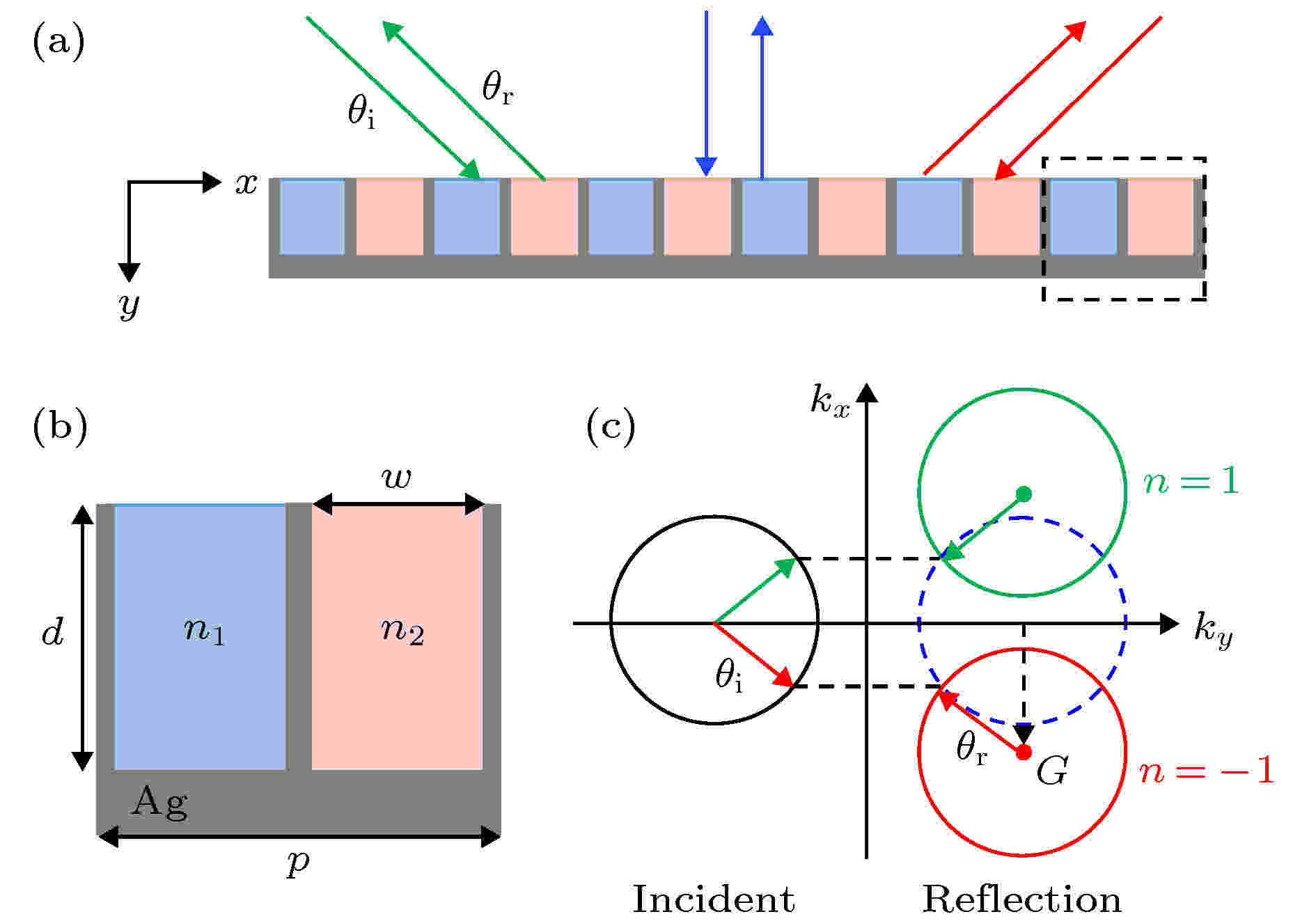
2020, 69 (1): 014211.
doi:10.7498/aps.69.20191144
Abstract +
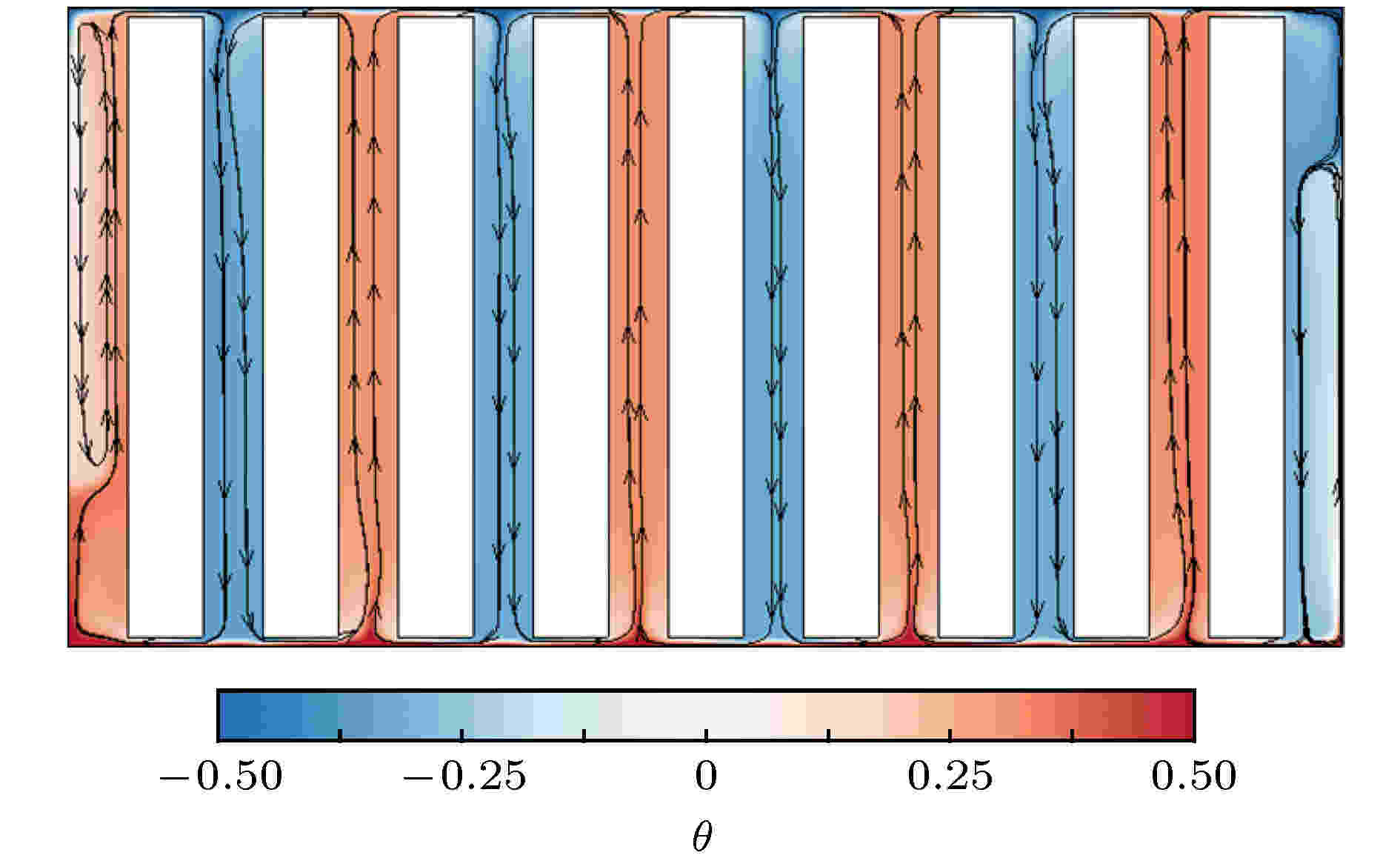
2020, 69 (1): 014401.
doi:10.7498/aps.69.20191193
Abstract +
How to improve the heat transfer efficiency of the system is always a hot issue in thermal convection research field. It is found that when the partitions are added at equal distances to the classical physical model -- Rayleigh-Bénard convection system and gaps are left between the horizontal plates and partitions, the heat transfer efficiency of the system increases significantly with the number of partitions increasing. The heat transfer efficiency can reach up to 3.1 times that of the non-partition device with the specific geometric parameters. In this paper, the Direct Numerical Simulation (DNS) method is used to simulate the partitioned convection system. The mechanism of the heat transfer enhancement of the system is analyzed by studying the characteristics of the heat flow as well as the heat conduction and transport in the system. After the flow in partitioned convection system is fully developed, the fluid in each channel moves vertically in alternating direction and the upward(downward) channel has a higher(lower) temperature than the average temperature of the cell. Due to the symmetry of the system, only the bottom region of the low temperature channel, the bottom region of the high temperature channel and the gap region connecting these two channels are selected for research. By discussing the lateral and longitudinal transport processes of heat flow in the above three regions, the heat flux in the channels and gap areas of the system are studied by quantitative analysis. The results show that the low-temperature fluid in the channel impacts on the bottom plate and then moves into the gap area; the fluid is continuously heated by the bottom plate and flows out of gap area with high temperature. Finally, the fluid converges in the heat transfer channel and forms a longitudinal jet. The external input heat flux of the area that has only horizontal heat transport is large, accounting for 92% of the total heat flux which is obtained from the bottom plate. The heat flux of gap area accounts for 64% of the total heat flux, but the external input heat flux of the area that has only longitudinal heat transport is smaller. The convection system with different geometric parameters has the effect of enhancing heat transfer efficiency, and enhancement capability of the system is stronger when the height of gaps is smaller. When the number of partitionsn= 11 and the height of gapd= 0.01, the value of the globalNunumber is largest,Nu= 82, which is more than three times that of the system without partitions.
CONDENSED MATTER: STRUCTURAL, MECHANICAL, AND THERMAL PROPERTIES
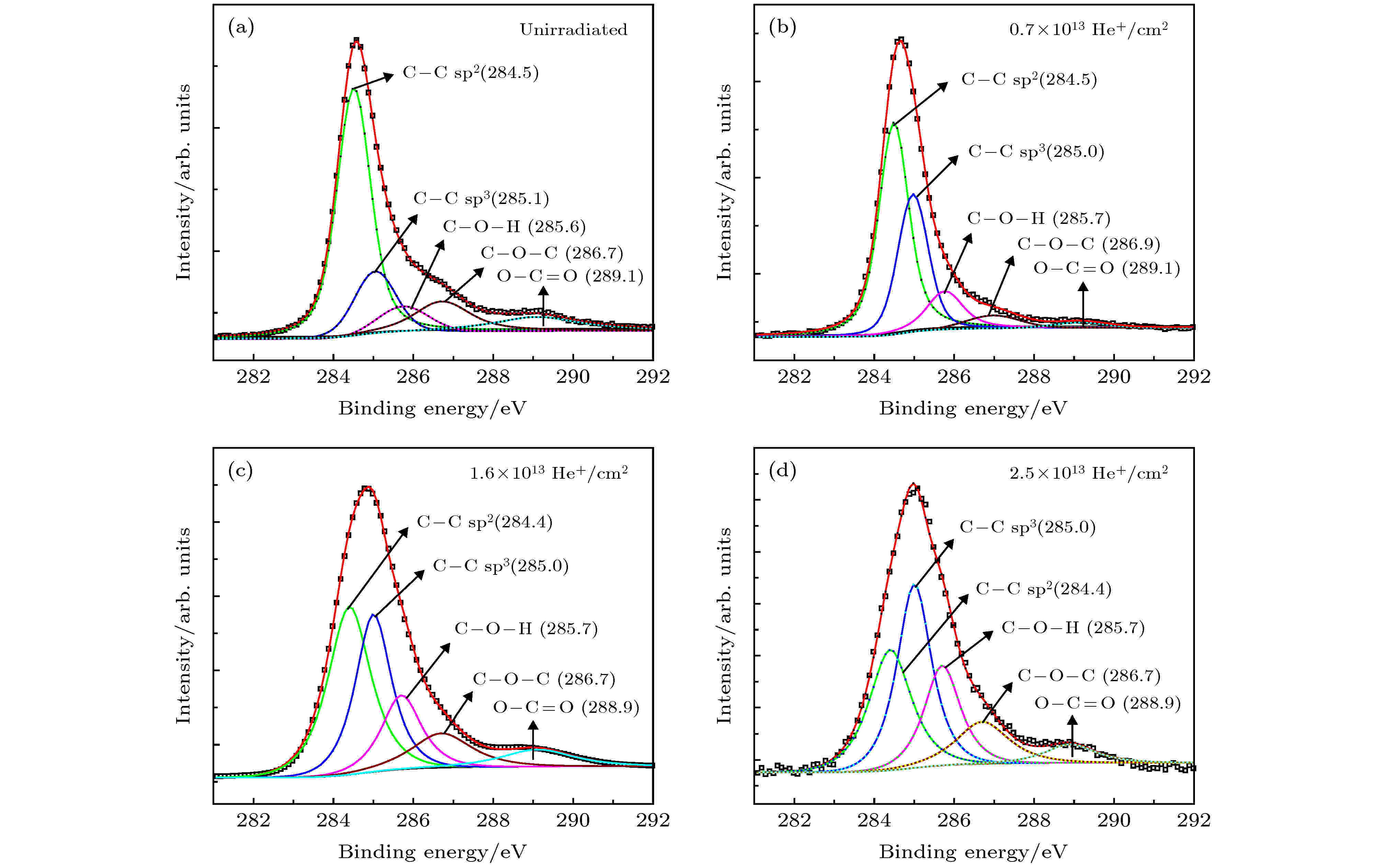
2020, 69 (1): 016101.
doi:10.7498/aps.69.20191344
Abstract +
Graphene is a planar two-dimensional material composed of sp2-bonded carbon atoms with extraordinary electrical, optical and mechanical properties, and considered as one of the revolutionary electronic component materials in the future. Some studies have shown that the inert gas ion irradiation as a defect introducing technique can change the structure and properties of graphene without introducing additional effects. In this paper, the 5.4 keV He ion irradiation at the dose ranging from 0.7 × 1013cm–2to 2.5 × 1013cm–2has a strong effect on graphene deposited by CVD technology. The X-ray photoelectron spectroscopy (XPS), Raman spectroscopy (Raman) and semi-conductor parameter analysis instrument are used to study the changes in the microstructure and electrical properties of graphene before and after irradiation. Detailed analysis shows that the defect density increases gradually with the irradiation dose increasing. Raman spectrum shows that when the irradiation dose increases to 1.6 × 1013cm–2, the value ofID/IGbegins to decrease, and XPS shows that the irradiation changes the structure of C chemical bond in graphene which causes the bonding state of C—C sp2to be destroyed and partly converted into the C—C sp3bonding state. Therefore, the structure of graphene begins to transform from nano-crystalline structure into sp3amorphous structure. Simultaneously, increasing defects causes the graphene conductivity to continuously decrease, and also gives rise to the electrical transition from defect scattering mechanism based on Boltzmann transport to the hopping transport. The positive voltage direction offset ofVdiracincreases nearly in direct proportion, which is due to the enhancement of graphene’s p-type doping effect caused by defects and adsorbed impurities. This work conduces to the understanding the mechanism of He ion interaction with graphene, and also provides an effective way of controlling the electronic properties.
CONDENSED MATTER: ELECTRONIC STRUCTURE, ELECTRICAL, MAGNETIC, AND OPTICAL PROPERTIES
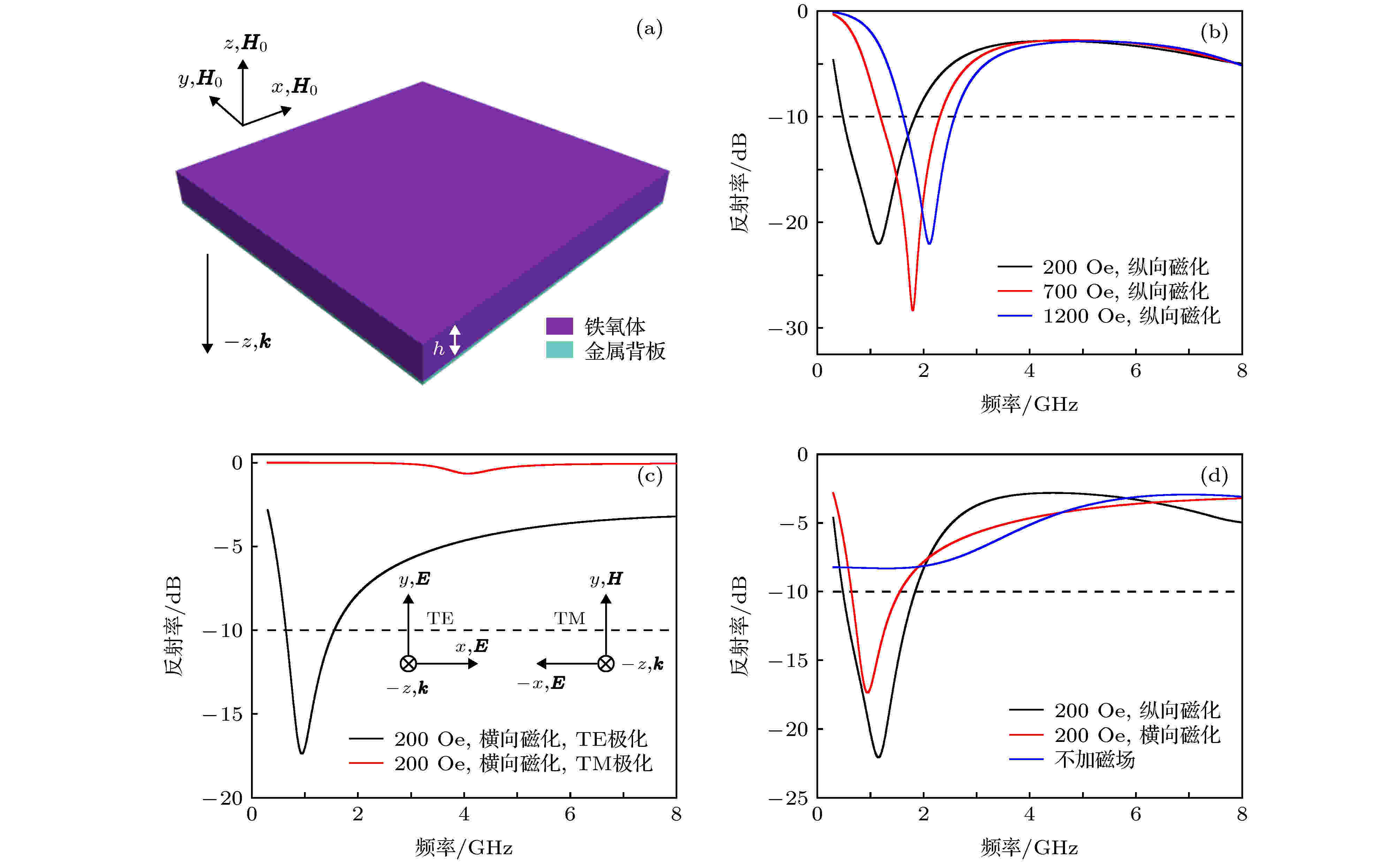
EDITOR'S SUGGESTION
2020, 69 (1): 017801.
doi:10.7498/aps.69.20191229
Abstract +
Under the action of static bias magnetic field, the magnetized ferrite has a permeability tensor which can be adjusted by the applied magnetic field. In this paper, the absorption properties of bulk gyromagnetic ferrites under different magnetized conditions are studied and the great potential of gyromagnetic ferrite in achieving low frequency electromagnetic wave absorption is demonstrated. Full wave electromagnetic simulations are performed based on the finite element method (FEM). A floquet port is adopted at the top boundary of the unit cell to simulate a normally incident plane wave. The unit cell boundary conditions are used in thex-yplane to simulate a periodic structure. Orthogonality magnetization in plane is utilized to solve the polarization selectivity in the condition of transverse magnetic field. The influence on absorption capacity of discrete ferrite array structure and the coupling effect of ferrite elements with different sizes are also studied in consideration of the size effect. The simulation results show that a thin bulk gyromagnetic ferrite layer whose thickness is only 4 mm can possess frequency as low as 0.48 GHz and reflectivity below –10 dB. Gyromagnetic ferrite presents different absorption properties under longitudinal magnetization and transversal magnetization, and different polarization directions in transversal magnetization as well. When longitudinal bias magnetic fieldH0= 200 Oe, the bandwidth of the reflectivity below –10 dB ranges from 0.48 to 1.84 GHz. The resonant absorption frequency can be regulated by adjusting bias magnetic field and the size of ferrite element. In general, a large bias magnetic field leads to a high resonant frequency due to the ferromagnetic resonance frequency positively associated with the applied magnetic field, but a ferrite array consisting of larger size elements provides a lower resonant frequency for the size resonance negatively associated with the size. By introducing the coupling between elements with different sizes, the reflection bandwidth below –10 dB can be effectively extended to above 80% of the sum of the bandwidth possessed by single unit cell, especially 105.7% under transversal bias magnetic field 700 Oe. And the broadening effect is effective in both longitudinal and transverse magnetized state but it will be weaker when the two absorption peaks are closer. To further understand the absorption mechanism of the two-element absorber, the distribution of the electric field, magnetic field and power loss density are examined. The results prove that the two peaks at the lower frequency exactly originates from
$ \Delta R = 0$
and the higher frequency originates from
$ \Delta R = 4$
, and therefore the widened absorption is contributed by the coupled multiple resonances provided by the elements with different sizes.
INTERDISCIPLINARY PHYSICS AND RELATED AREAS OF SCIENCE AND TECHNOLOGY
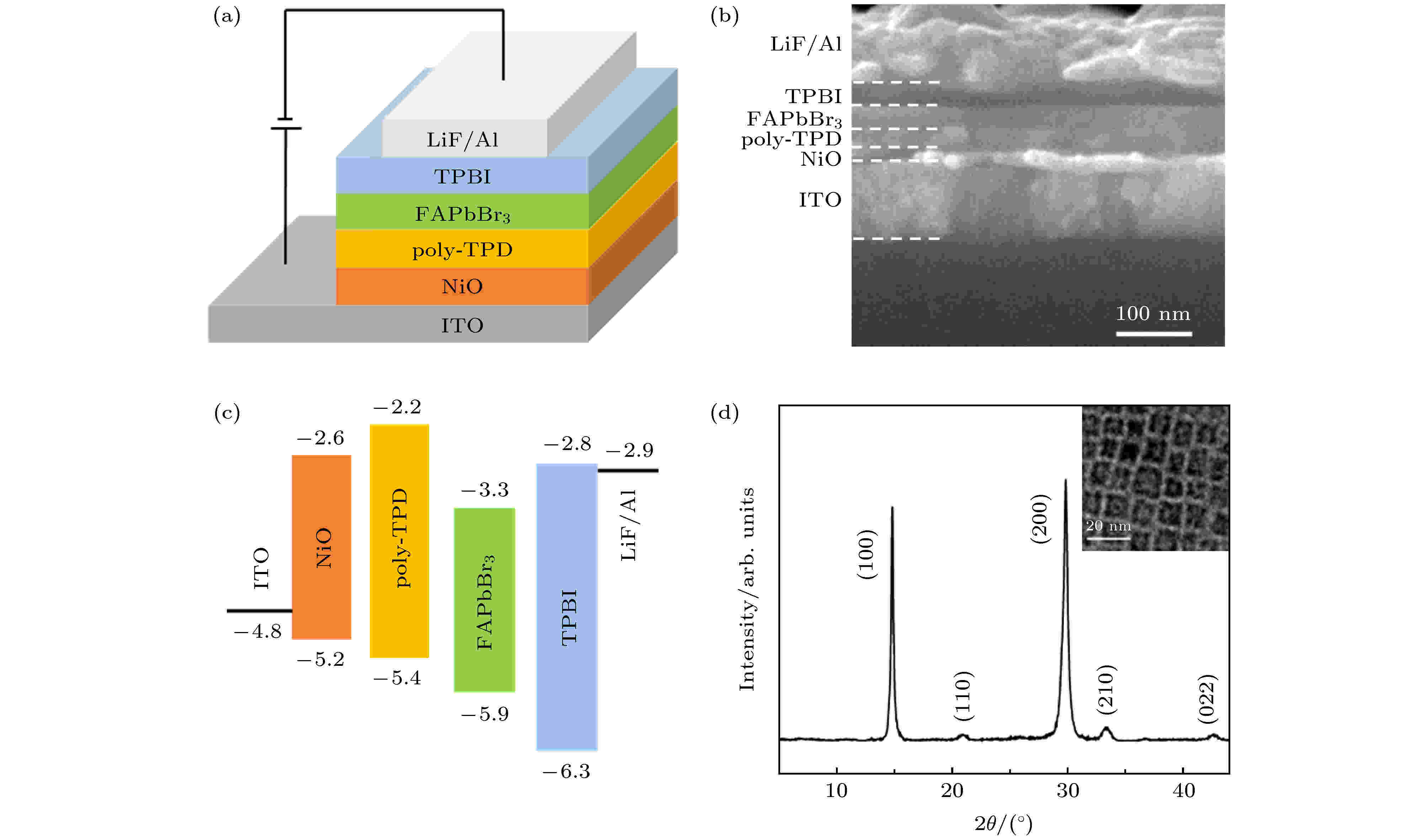
EDITOR'S SUGGESTION
2020, 69 (1): 018101.
doi:10.7498/aps.69.20191269
Abstract +
Formamidinium lead bromide (FAPbBr3) perovskite nanocrystals (NCs) have attracted great attention due to their remarkable performances of low cost, high color purity and tunable band gap. However, in a typical FAPbBr3perovskite light-emitting diode(LED), PEDOT:PSS, with hygroscopic and acidic nature, serves as a hole injection layer (HIL), thus leading to the device stability to decrease seriously. Device stability is one critical issue that needs improving for future applications. Here in this study, the nickel oxide (NiO) film prepared by the solution method is adopted as the HIL of the FAPbBr3perovskite LED to substitute detrimental PEDOT:PSS. Compared with the control device with PEDOT:PSS HIL, the resulting LED based on NiO film has the operating lifetime twice as great as that based on the PEDOT:PSS film. For further enhancing the performance of FAPbBr3LED, two metal dopants (Cs and Li) are introduced to improve the hole injection capability of NiO film and the charge carriers’ balance of device. With Hall measurements, both NiO and Cs/Li-doped NiO demonstrate a full p-type semiconductor characteristic. Increasing the doping concentration in the film can increase the carrier concentration and reduce the carrier mobility. This decreased carrier mobility results from the increased scattering due to grain boundaries and impurity phases, seriously at high Cs/Li concentration. As a result, the device, based on the NiO film (doping 2 mol% Cs) shows the best performance with a maximum brightness value of 2970 cd/m2, current efficiency of 43 cd/A and external quantum efficiency (EQE) of 11.0%, thus its efficiency is increased nearly by twice compared with that of the PEDOT:PSS-based device. The results pave the way for making highly efficient and stability perovskite LEDs based on FAPbBr3NCs.
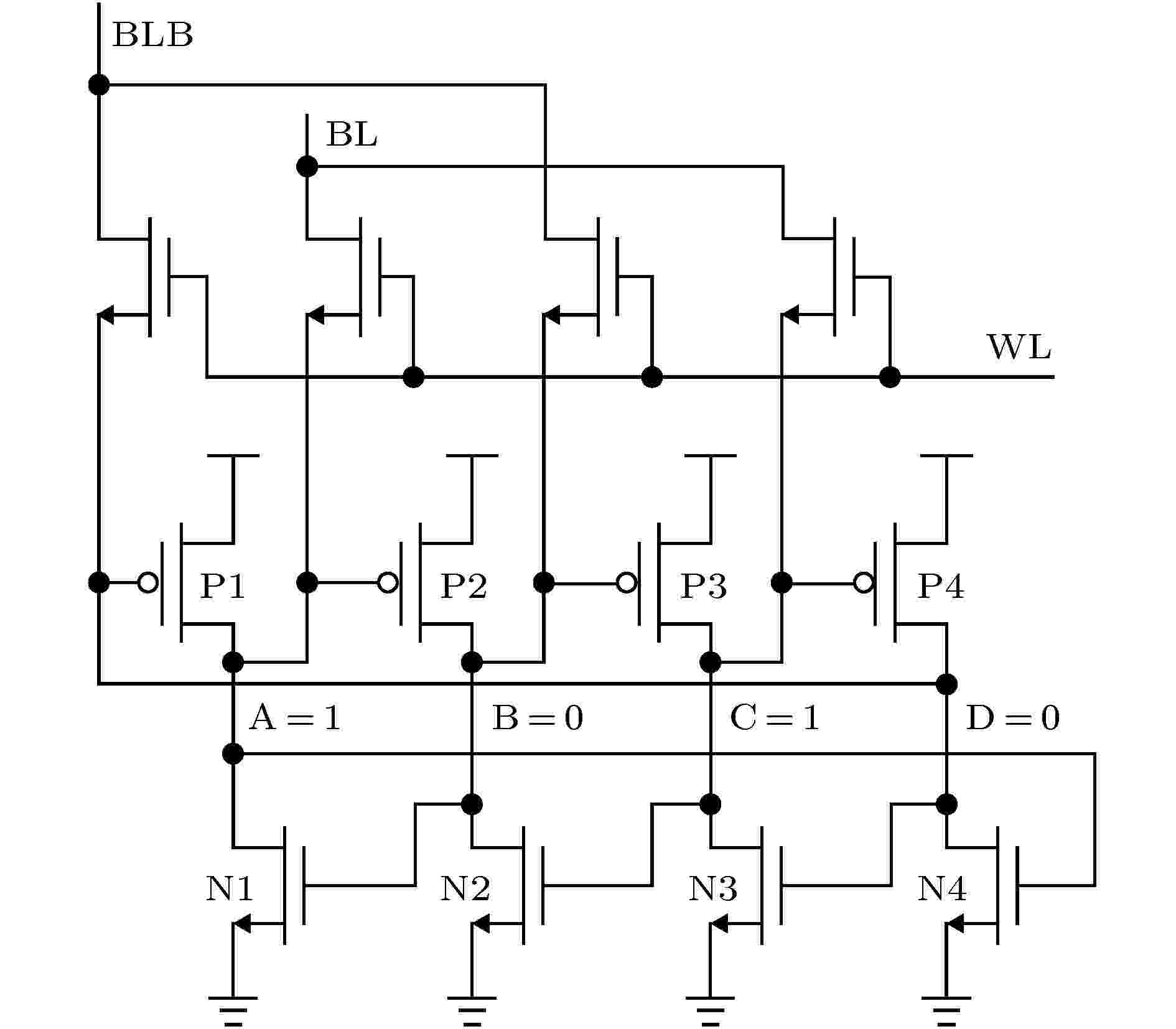
2020, 69 (1): 018501.
doi:10.7498/aps.69.20190878
Abstract +
In order to evaluate the radiation tolerance to proton single event effect(SEE) in nanometer dual interlocked cell (DICE) hardening device accurately, single event upset (SEU) linear energy transfer (LET) threshold at heavy ion normal and tilt incidence, and the worst case SEU orientational angle are acquired based on the analysis of heavy ion SEU testing data in 65 nm dual DICE static random access memory (SRAM). It is proved that dual DICE design is effective for improving the LET threshold against SEU. Howerer, heavy ion tilt incidence at the worst orientational angle will significantly reduce the SEU threshold and increase the SEU cross section. The worst orientational angle for SEU in DICE SRAM is the large tilting angle along the well. The maximum LET value and the emission angle distribution of secondary particle induced by the nuclear reaction between protons with different energy and layers with different multiple metallization are obtained by using Monte-Carlo simulation. The maximum LET value of secondary particle from proton-copper spallation reaction is higher than 15 MeV·cm2/mg for 100 MeV and 200 MeV protons. Secondary particles with the maximum energy and longest range are emitted preferentially in the forward direction. Proton SEU sensitivity is further predicted through combining heavy ion test data with Monte-Carlo simulation. Proton SEU test data verify the effectiveness of the prediction method and the accuracy of the prediction results. The research results indicate that the tolerance of nanometer DICE hardening technique against proton SEU will be overestimated if SEE evaluation test is carried out with only 100 MeV proton accelerator or normal incidence. Proton single event upset in nanometer dual DICE SRAM has an evident dependence on tilt angle and orientational angle. By adopting the above prediction method, whether proton SEE test needs performing or not in nanometer radiation-hardening device can be judged and screened. The requirements for the maximum energy of proton accelerator can be ascertained. In order to ensure that the devices are applied to space with high reliability, SEE test should be carried out including tilt incidence at the worst orientational angle in nanometer DICE hardening device in the process of heavy ion and proton SEE test evaluation.
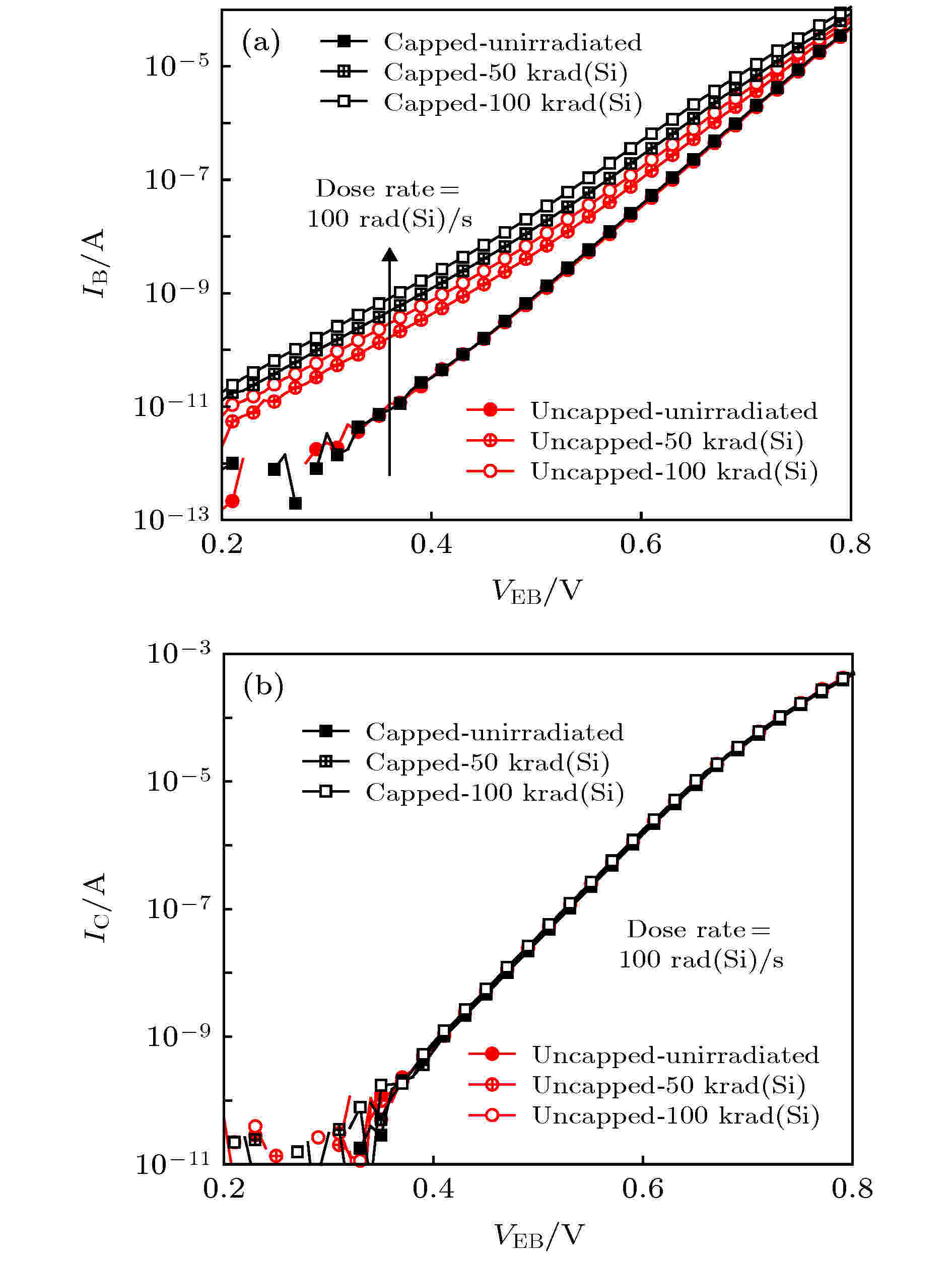
2020, 69 (1): 018502.
doi:10.7498/aps.69.20191151
Abstract +
GEOPHYSICS, ASTRONOMY, AND ASTROPHYSICS
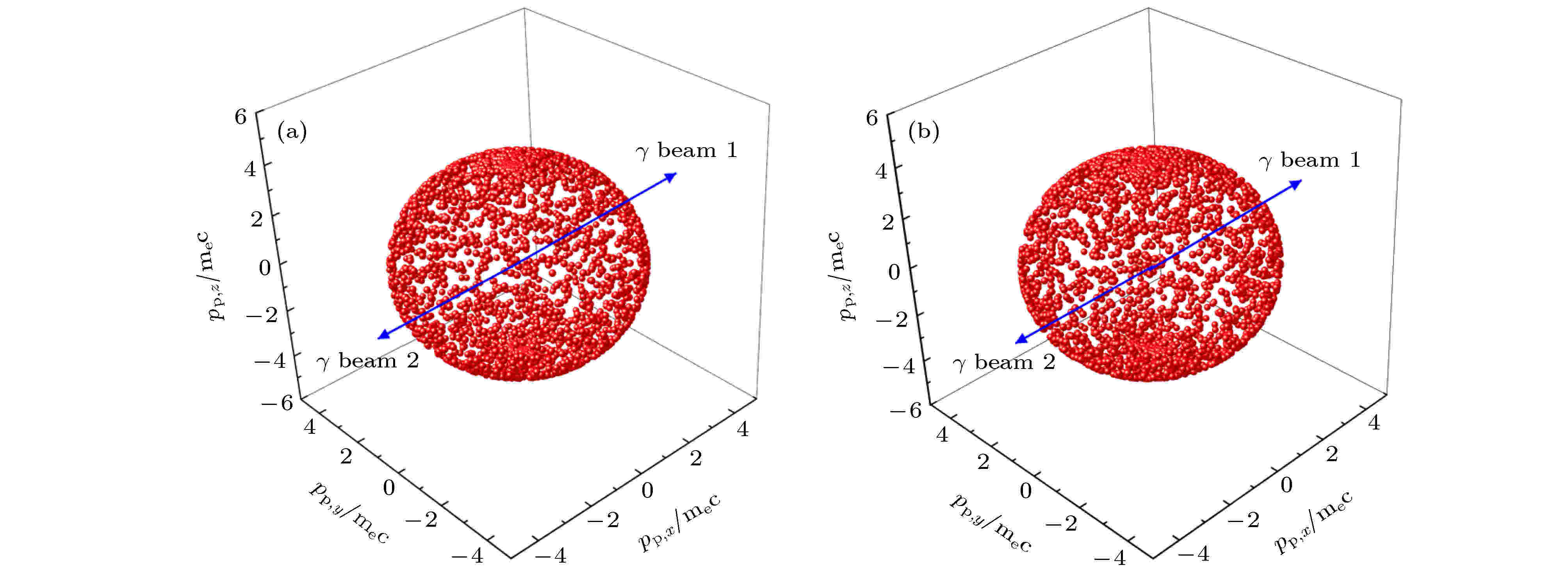
2020, 69 (1): 019501.
doi:10.7498/aps.69.20190729
Abstract +
The creation of positron and electron pairs through photon-photon collision, named Breit-Wheeler process, has been well understood in the theories of quantum electrodynamics for nearly 100 years. The photon-photon collision, which is one of the most basic processes of matter generation in the universe, has not been observed yet. The study on photon-photon collision can promote the development of two-photon physics, quantum electrodynamics theories and high energy physics. To observe photon-photon collision in the laboratory, one needs to collimate a huge number of energetic γ-ray photons into a very small spot. Recently, the development of highly collomated source generated by 10 PW laser makes photon-photon collider much more possible than before. In photon-photon collider, the study of numerical simulation plays a critical role since no experiment has achieved such a process. In this paper, a new numerical method is developed to handle the two-photon Breit-Wheeler process. This method is based on the exact two-photon collision dynamic principle, including energy threshold condition, cross-section condition, Lorentz transformation, etc. In the method, the photons are divided into quantitative photon blocks based on the spatial coordinates. Firstly, one needs to find the collision blocks according to the spatial motion law. Secondly, the ergodic method is used to look up the photons that satisfy the energy threshold condition and the cross-section condition from the blocks. Then, one can calculate the electron yield of the photon collision, and the kinetic parameters of the positrons and electrons. This method rigorously follows the physical principle so it has high precision. On the other hand, this method determines the collision of the block in advance, which can reduce the computational requirement a lot. A series of tests is carried out to confirm the accuracy and feasibility of this numerical method by calculating the collision between mono-energetic photon beams. In the tests, the collision angle is assumed to 180° and 60° separately, the results of pair momentum distribution are discussed. We also simulate the collision of the γ-ray beams generated through the interaction between ultra-intense laser and narrow tube targets. In the simulations, the collision angle is changed from 170° to 30° to see its effect on pair production. It is found that the yield of electron-positron pairs decreases with collision angle increasing, which has also been reported in previous work. Therefore, this numerical method can be efficiently used for modeling photon-photon collider, and provide theoretical reference and suggestion to the future experimental design of γ-ray collision.
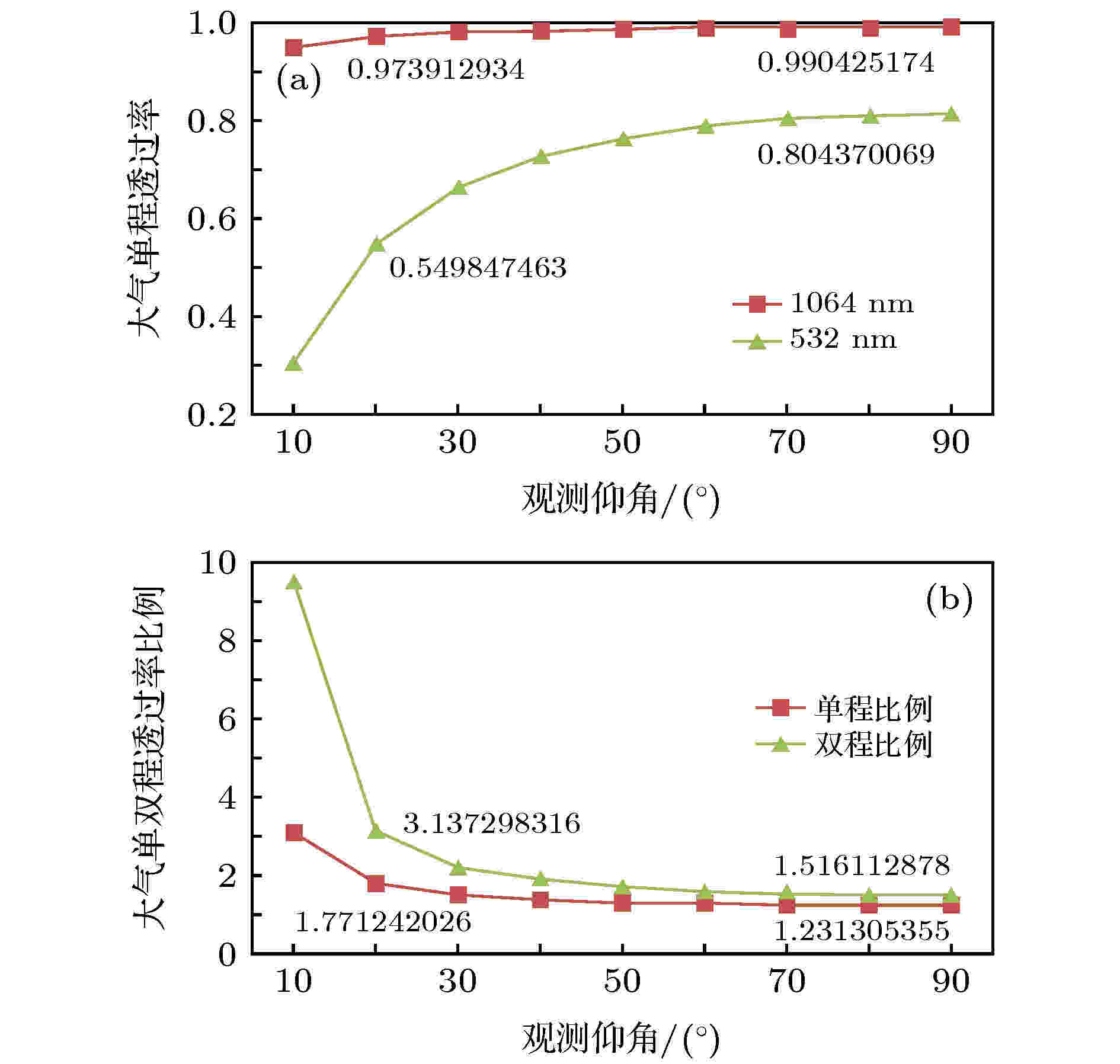
2020, 69 (1): 019502.
doi:10.7498/aps.69.20191299
Abstract +
Classical satellite laser ranging (SLR) technology based on 532 nm wavelength usually adopts low energy laser to measure cooperative objects. However, for a very weak target, such as debris and lunar reflector arrays, laser ranging system should have much stronger detection capability than the laser ranging system for traditional application. A common way to improve system detection capability is to use high energy laser. With an additional frequency doubling crystal, it is more difficult to make a high energy laser based on 532 nm than that based on 1.06 μm, which restricts the improvement of system detection capability, and also gives rise to the short lifetime, poor system stability problems. Compared with 532 nm laser, the 1.06 μm laser has many advantages of high laser energy and power, high atmospheric transmissivity, and low background noise, thereby making it an ideal substitution for the traditional 532 nm SLR system. In this paper, we comparatively analyze the above-mentiond advantages of the 1.06 μm laser and other system’s key parameters such as detector efficiency and target reflection efficiency, calculate the echo photons one can obtain, and establish a 1.06 μm laser ranging system based on the existing 532 nm SLR at Shanghai Astronomical Observatory. Owing to the using of an InGaAs single photon detector, the system turns very compact, low cost, easy-to-be-installed and has almost no additional operation complexity than the 532 nm system. With this system, the high precision 1.06 μm laser ranging for cooperative objects based on InGaAs detector is carried out for the first time in China, and a ranging for space debris 1500 km away can also be realized. The ranging experiment shows with the same laser, SLR using 1.06 μm output reaches a detection efficiency of 7 times the detection efficiency the SLR using 532 nm output reaches, and the background noise only 1/5. This approves the advantages and feasibility of 1.06 μm system, and also shows its great potential application prospects in the high precision weak target laser detection in the day and night time. This paper provides a very easy operation, high compact and low cost method for the future high precision weak target laser ranging.






























